Prevention of Cyber Fraud - Study Material and Solved Assignments
VerifiedAdded on 2022/11/01
|19
|4599
|187
AI Summary
This report provides a thorough understanding of cyber fraud and cybercrime aspects, reflecting some of the cyber fraud incidents that took place in the past and helps in understanding the legal policies that have been incorporated by the government and various organizations in order to deal with these threats. It discusses the definition and scale of the problem, elements of the crime, criminal methodologies, victimization, and prevention approaches. The subject is cyber security and the course code is not mentioned. The document type is a report and the assignment type is not mentioned.
Contribute Materials
Your contribution can guide someone’s learning journey. Share your
documents today.
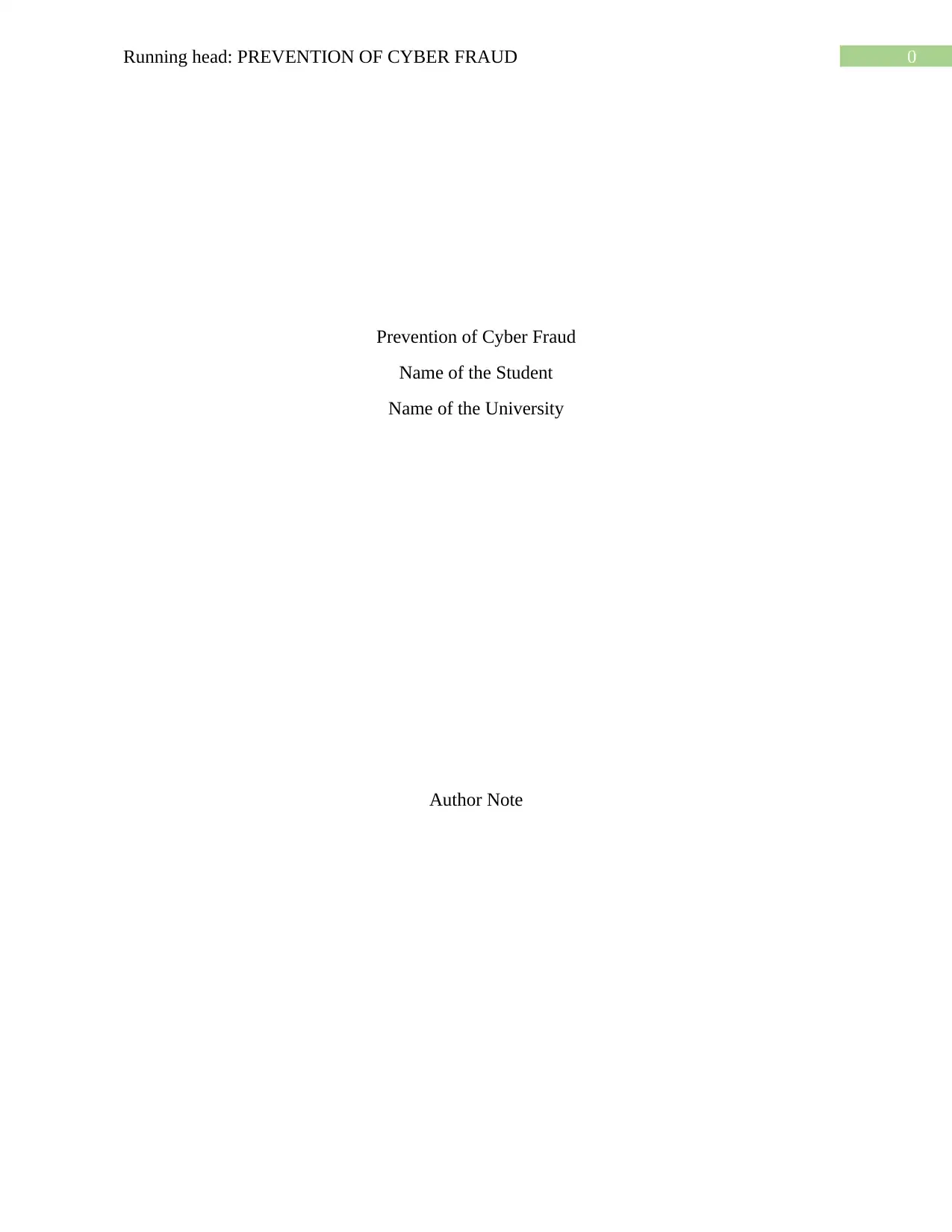
0Running head: PREVENTION OF CYBER FRAUD
Prevention of Cyber Fraud
Name of the Student
Name of the University
Author Note
Prevention of Cyber Fraud
Name of the Student
Name of the University
Author Note
Secure Best Marks with AI Grader
Need help grading? Try our AI Grader for instant feedback on your assignments.
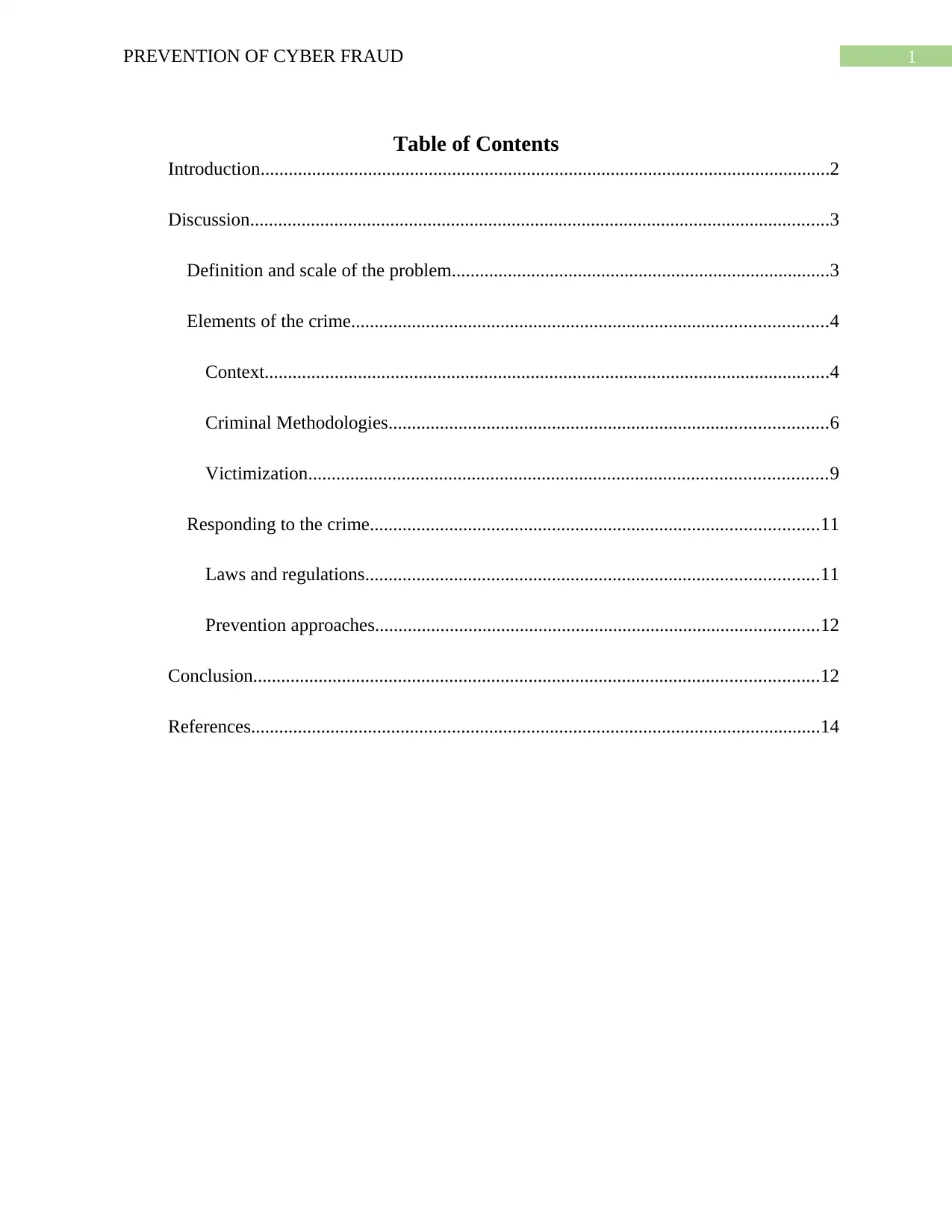
1PREVENTION OF CYBER FRAUD
Table of Contents
Introduction..........................................................................................................................2
Discussion............................................................................................................................3
Definition and scale of the problem.................................................................................3
Elements of the crime......................................................................................................4
Context.........................................................................................................................4
Criminal Methodologies..............................................................................................6
Victimization...............................................................................................................9
Responding to the crime................................................................................................11
Laws and regulations.................................................................................................11
Prevention approaches...............................................................................................12
Conclusion.........................................................................................................................12
References..........................................................................................................................14
Table of Contents
Introduction..........................................................................................................................2
Discussion............................................................................................................................3
Definition and scale of the problem.................................................................................3
Elements of the crime......................................................................................................4
Context.........................................................................................................................4
Criminal Methodologies..............................................................................................6
Victimization...............................................................................................................9
Responding to the crime................................................................................................11
Laws and regulations.................................................................................................11
Prevention approaches...............................................................................................12
Conclusion.........................................................................................................................12
References..........................................................................................................................14
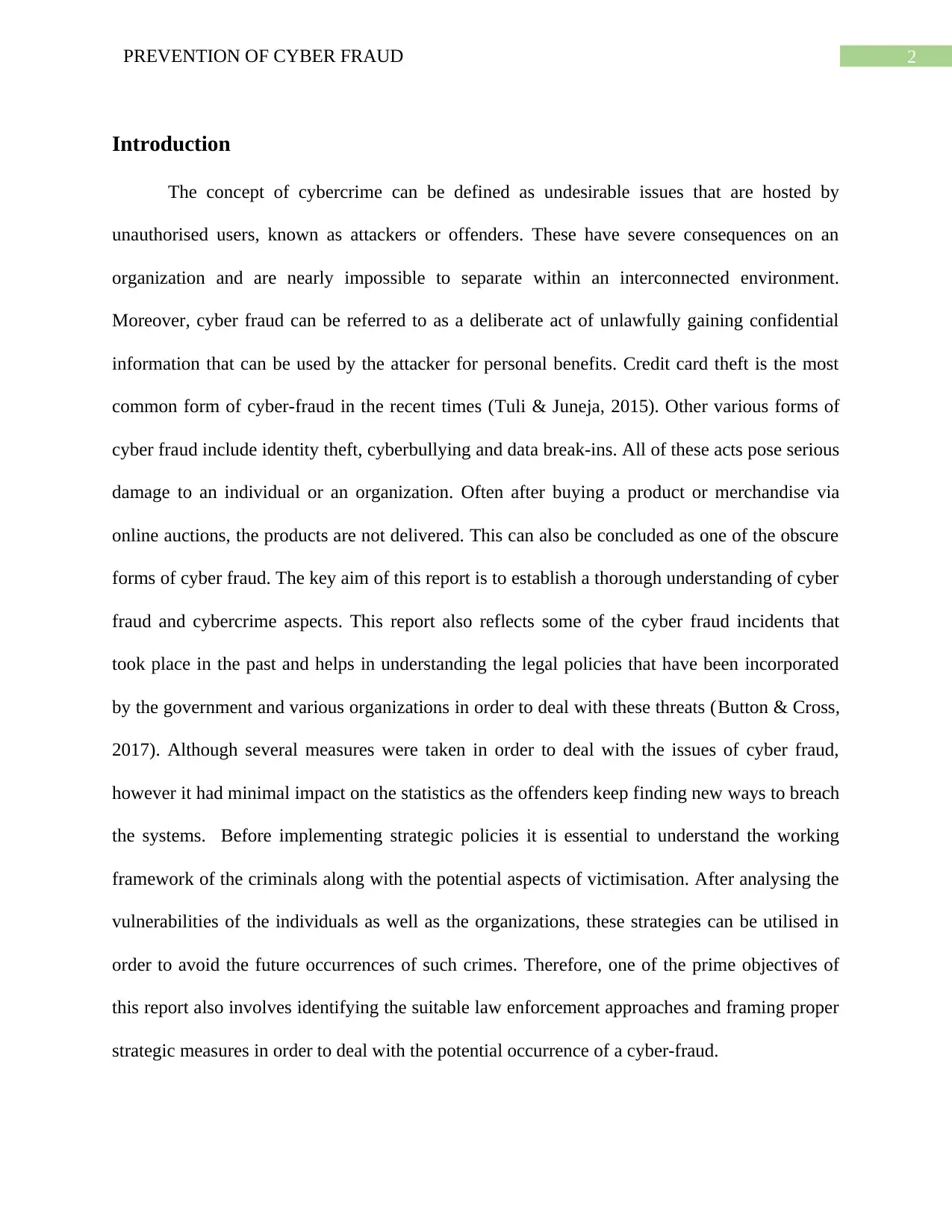
2PREVENTION OF CYBER FRAUD
Introduction
The concept of cybercrime can be defined as undesirable issues that are hosted by
unauthorised users, known as attackers or offenders. These have severe consequences on an
organization and are nearly impossible to separate within an interconnected environment.
Moreover, cyber fraud can be referred to as a deliberate act of unlawfully gaining confidential
information that can be used by the attacker for personal benefits. Credit card theft is the most
common form of cyber-fraud in the recent times (Tuli & Juneja, 2015). Other various forms of
cyber fraud include identity theft, cyberbullying and data break-ins. All of these acts pose serious
damage to an individual or an organization. Often after buying a product or merchandise via
online auctions, the products are not delivered. This can also be concluded as one of the obscure
forms of cyber fraud. The key aim of this report is to establish a thorough understanding of cyber
fraud and cybercrime aspects. This report also reflects some of the cyber fraud incidents that
took place in the past and helps in understanding the legal policies that have been incorporated
by the government and various organizations in order to deal with these threats (Button & Cross,
2017). Although several measures were taken in order to deal with the issues of cyber fraud,
however it had minimal impact on the statistics as the offenders keep finding new ways to breach
the systems. Before implementing strategic policies it is essential to understand the working
framework of the criminals along with the potential aspects of victimisation. After analysing the
vulnerabilities of the individuals as well as the organizations, these strategies can be utilised in
order to avoid the future occurrences of such crimes. Therefore, one of the prime objectives of
this report also involves identifying the suitable law enforcement approaches and framing proper
strategic measures in order to deal with the potential occurrence of a cyber-fraud.
Introduction
The concept of cybercrime can be defined as undesirable issues that are hosted by
unauthorised users, known as attackers or offenders. These have severe consequences on an
organization and are nearly impossible to separate within an interconnected environment.
Moreover, cyber fraud can be referred to as a deliberate act of unlawfully gaining confidential
information that can be used by the attacker for personal benefits. Credit card theft is the most
common form of cyber-fraud in the recent times (Tuli & Juneja, 2015). Other various forms of
cyber fraud include identity theft, cyberbullying and data break-ins. All of these acts pose serious
damage to an individual or an organization. Often after buying a product or merchandise via
online auctions, the products are not delivered. This can also be concluded as one of the obscure
forms of cyber fraud. The key aim of this report is to establish a thorough understanding of cyber
fraud and cybercrime aspects. This report also reflects some of the cyber fraud incidents that
took place in the past and helps in understanding the legal policies that have been incorporated
by the government and various organizations in order to deal with these threats (Button & Cross,
2017). Although several measures were taken in order to deal with the issues of cyber fraud,
however it had minimal impact on the statistics as the offenders keep finding new ways to breach
the systems. Before implementing strategic policies it is essential to understand the working
framework of the criminals along with the potential aspects of victimisation. After analysing the
vulnerabilities of the individuals as well as the organizations, these strategies can be utilised in
order to avoid the future occurrences of such crimes. Therefore, one of the prime objectives of
this report also involves identifying the suitable law enforcement approaches and framing proper
strategic measures in order to deal with the potential occurrence of a cyber-fraud.
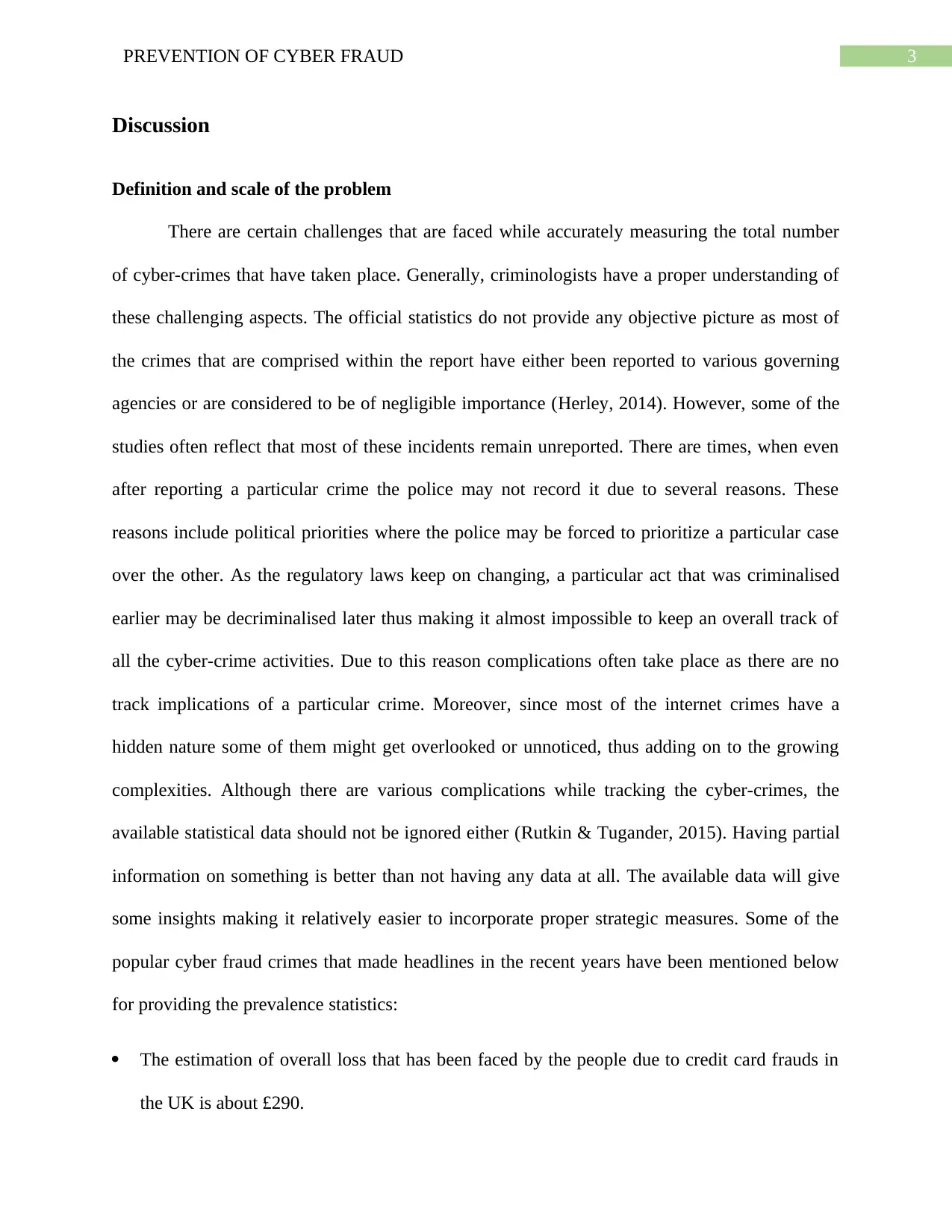
3PREVENTION OF CYBER FRAUD
Discussion
Definition and scale of the problem
There are certain challenges that are faced while accurately measuring the total number
of cyber-crimes that have taken place. Generally, criminologists have a proper understanding of
these challenging aspects. The official statistics do not provide any objective picture as most of
the crimes that are comprised within the report have either been reported to various governing
agencies or are considered to be of negligible importance (Herley, 2014). However, some of the
studies often reflect that most of these incidents remain unreported. There are times, when even
after reporting a particular crime the police may not record it due to several reasons. These
reasons include political priorities where the police may be forced to prioritize a particular case
over the other. As the regulatory laws keep on changing, a particular act that was criminalised
earlier may be decriminalised later thus making it almost impossible to keep an overall track of
all the cyber-crime activities. Due to this reason complications often take place as there are no
track implications of a particular crime. Moreover, since most of the internet crimes have a
hidden nature some of them might get overlooked or unnoticed, thus adding on to the growing
complexities. Although there are various complications while tracking the cyber-crimes, the
available statistical data should not be ignored either (Rutkin & Tugander, 2015). Having partial
information on something is better than not having any data at all. The available data will give
some insights making it relatively easier to incorporate proper strategic measures. Some of the
popular cyber fraud crimes that made headlines in the recent years have been mentioned below
for providing the prevalence statistics:
The estimation of overall loss that has been faced by the people due to credit card frauds in
the UK is about £290.
Discussion
Definition and scale of the problem
There are certain challenges that are faced while accurately measuring the total number
of cyber-crimes that have taken place. Generally, criminologists have a proper understanding of
these challenging aspects. The official statistics do not provide any objective picture as most of
the crimes that are comprised within the report have either been reported to various governing
agencies or are considered to be of negligible importance (Herley, 2014). However, some of the
studies often reflect that most of these incidents remain unreported. There are times, when even
after reporting a particular crime the police may not record it due to several reasons. These
reasons include political priorities where the police may be forced to prioritize a particular case
over the other. As the regulatory laws keep on changing, a particular act that was criminalised
earlier may be decriminalised later thus making it almost impossible to keep an overall track of
all the cyber-crime activities. Due to this reason complications often take place as there are no
track implications of a particular crime. Moreover, since most of the internet crimes have a
hidden nature some of them might get overlooked or unnoticed, thus adding on to the growing
complexities. Although there are various complications while tracking the cyber-crimes, the
available statistical data should not be ignored either (Rutkin & Tugander, 2015). Having partial
information on something is better than not having any data at all. The available data will give
some insights making it relatively easier to incorporate proper strategic measures. Some of the
popular cyber fraud crimes that made headlines in the recent years have been mentioned below
for providing the prevalence statistics:
The estimation of overall loss that has been faced by the people due to credit card frauds in
the UK is about £290.
Secure Best Marks with AI Grader
Need help grading? Try our AI Grader for instant feedback on your assignments.
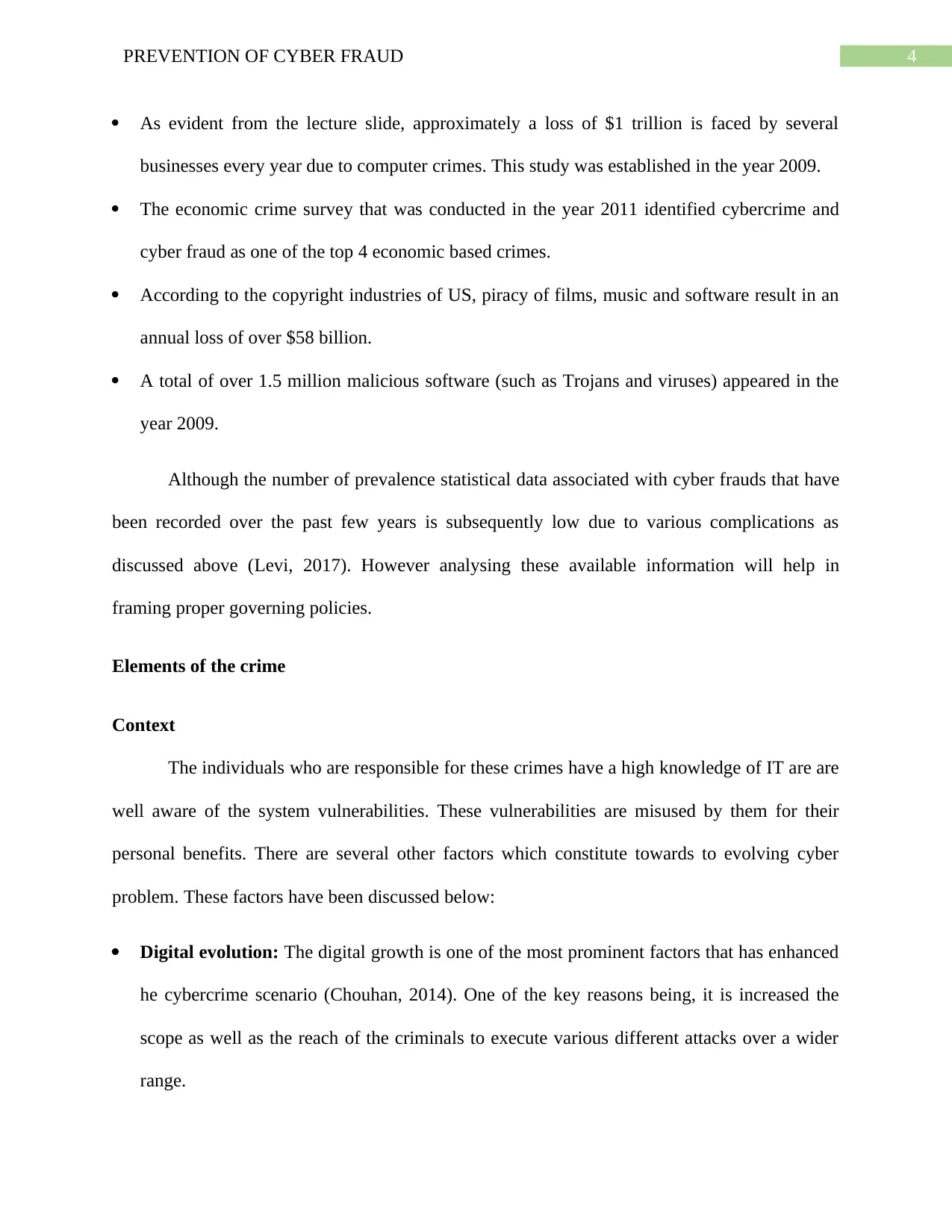
4PREVENTION OF CYBER FRAUD
As evident from the lecture slide, approximately a loss of $1 trillion is faced by several
businesses every year due to computer crimes. This study was established in the year 2009.
The economic crime survey that was conducted in the year 2011 identified cybercrime and
cyber fraud as one of the top 4 economic based crimes.
According to the copyright industries of US, piracy of films, music and software result in an
annual loss of over $58 billion.
A total of over 1.5 million malicious software (such as Trojans and viruses) appeared in the
year 2009.
Although the number of prevalence statistical data associated with cyber frauds that have
been recorded over the past few years is subsequently low due to various complications as
discussed above (Levi, 2017). However analysing these available information will help in
framing proper governing policies.
Elements of the crime
Context
The individuals who are responsible for these crimes have a high knowledge of IT are are
well aware of the system vulnerabilities. These vulnerabilities are misused by them for their
personal benefits. There are several other factors which constitute towards to evolving cyber
problem. These factors have been discussed below:
Digital evolution: The digital growth is one of the most prominent factors that has enhanced
he cybercrime scenario (Chouhan, 2014). One of the key reasons being, it is increased the
scope as well as the reach of the criminals to execute various different attacks over a wider
range.
As evident from the lecture slide, approximately a loss of $1 trillion is faced by several
businesses every year due to computer crimes. This study was established in the year 2009.
The economic crime survey that was conducted in the year 2011 identified cybercrime and
cyber fraud as one of the top 4 economic based crimes.
According to the copyright industries of US, piracy of films, music and software result in an
annual loss of over $58 billion.
A total of over 1.5 million malicious software (such as Trojans and viruses) appeared in the
year 2009.
Although the number of prevalence statistical data associated with cyber frauds that have
been recorded over the past few years is subsequently low due to various complications as
discussed above (Levi, 2017). However analysing these available information will help in
framing proper governing policies.
Elements of the crime
Context
The individuals who are responsible for these crimes have a high knowledge of IT are are
well aware of the system vulnerabilities. These vulnerabilities are misused by them for their
personal benefits. There are several other factors which constitute towards to evolving cyber
problem. These factors have been discussed below:
Digital evolution: The digital growth is one of the most prominent factors that has enhanced
he cybercrime scenario (Chouhan, 2014). One of the key reasons being, it is increased the
scope as well as the reach of the criminals to execute various different attacks over a wider
range.
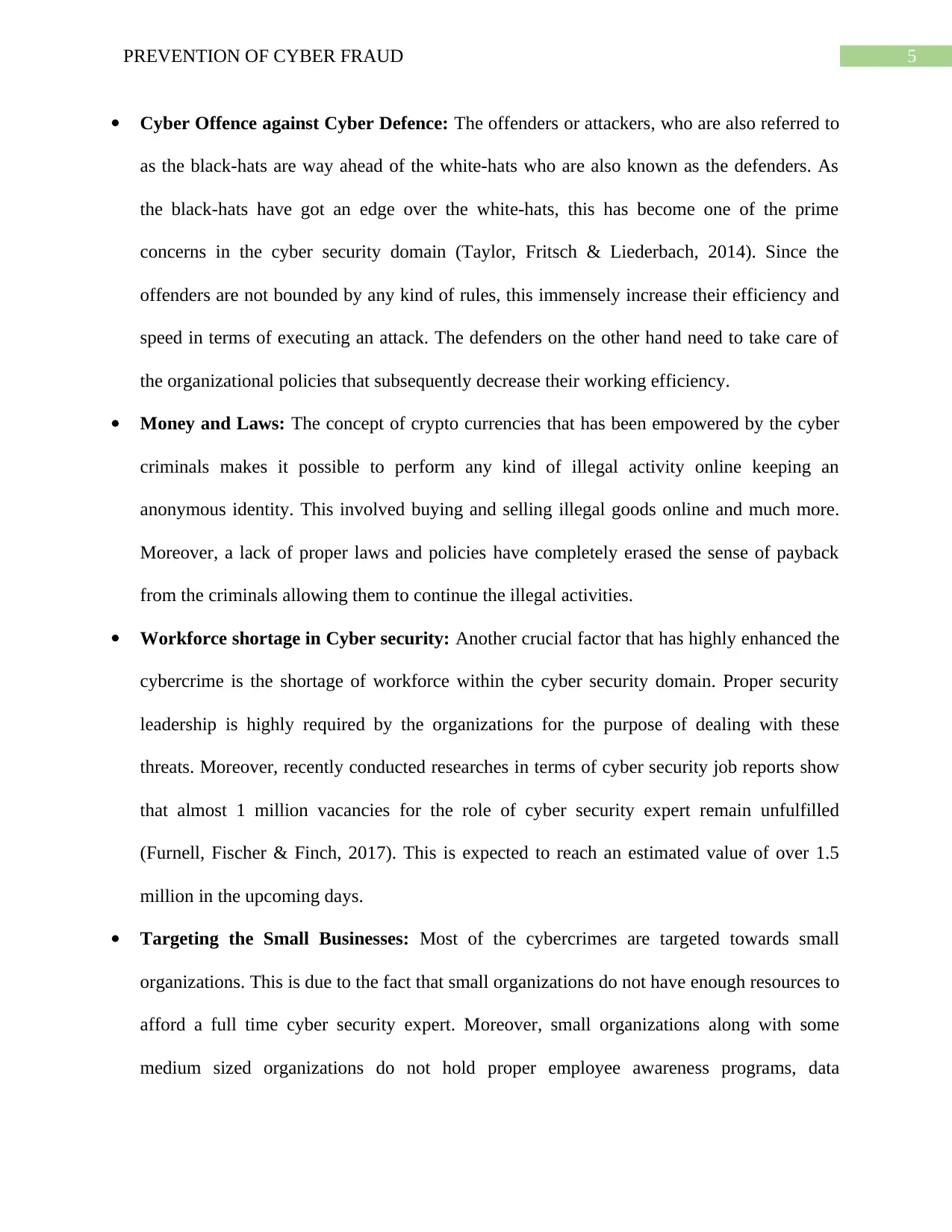
5PREVENTION OF CYBER FRAUD
Cyber Offence against Cyber Defence: The offenders or attackers, who are also referred to
as the black-hats are way ahead of the white-hats who are also known as the defenders. As
the black-hats have got an edge over the white-hats, this has become one of the prime
concerns in the cyber security domain (Taylor, Fritsch & Liederbach, 2014). Since the
offenders are not bounded by any kind of rules, this immensely increase their efficiency and
speed in terms of executing an attack. The defenders on the other hand need to take care of
the organizational policies that subsequently decrease their working efficiency.
Money and Laws: The concept of crypto currencies that has been empowered by the cyber
criminals makes it possible to perform any kind of illegal activity online keeping an
anonymous identity. This involved buying and selling illegal goods online and much more.
Moreover, a lack of proper laws and policies have completely erased the sense of payback
from the criminals allowing them to continue the illegal activities.
Workforce shortage in Cyber security: Another crucial factor that has highly enhanced the
cybercrime is the shortage of workforce within the cyber security domain. Proper security
leadership is highly required by the organizations for the purpose of dealing with these
threats. Moreover, recently conducted researches in terms of cyber security job reports show
that almost 1 million vacancies for the role of cyber security expert remain unfulfilled
(Furnell, Fischer & Finch, 2017). This is expected to reach an estimated value of over 1.5
million in the upcoming days.
Targeting the Small Businesses: Most of the cybercrimes are targeted towards small
organizations. This is due to the fact that small organizations do not have enough resources to
afford a full time cyber security expert. Moreover, small organizations along with some
medium sized organizations do not hold proper employee awareness programs, data
Cyber Offence against Cyber Defence: The offenders or attackers, who are also referred to
as the black-hats are way ahead of the white-hats who are also known as the defenders. As
the black-hats have got an edge over the white-hats, this has become one of the prime
concerns in the cyber security domain (Taylor, Fritsch & Liederbach, 2014). Since the
offenders are not bounded by any kind of rules, this immensely increase their efficiency and
speed in terms of executing an attack. The defenders on the other hand need to take care of
the organizational policies that subsequently decrease their working efficiency.
Money and Laws: The concept of crypto currencies that has been empowered by the cyber
criminals makes it possible to perform any kind of illegal activity online keeping an
anonymous identity. This involved buying and selling illegal goods online and much more.
Moreover, a lack of proper laws and policies have completely erased the sense of payback
from the criminals allowing them to continue the illegal activities.
Workforce shortage in Cyber security: Another crucial factor that has highly enhanced the
cybercrime is the shortage of workforce within the cyber security domain. Proper security
leadership is highly required by the organizations for the purpose of dealing with these
threats. Moreover, recently conducted researches in terms of cyber security job reports show
that almost 1 million vacancies for the role of cyber security expert remain unfulfilled
(Furnell, Fischer & Finch, 2017). This is expected to reach an estimated value of over 1.5
million in the upcoming days.
Targeting the Small Businesses: Most of the cybercrimes are targeted towards small
organizations. This is due to the fact that small organizations do not have enough resources to
afford a full time cyber security expert. Moreover, small organizations along with some
medium sized organizations do not hold proper employee awareness programs, data
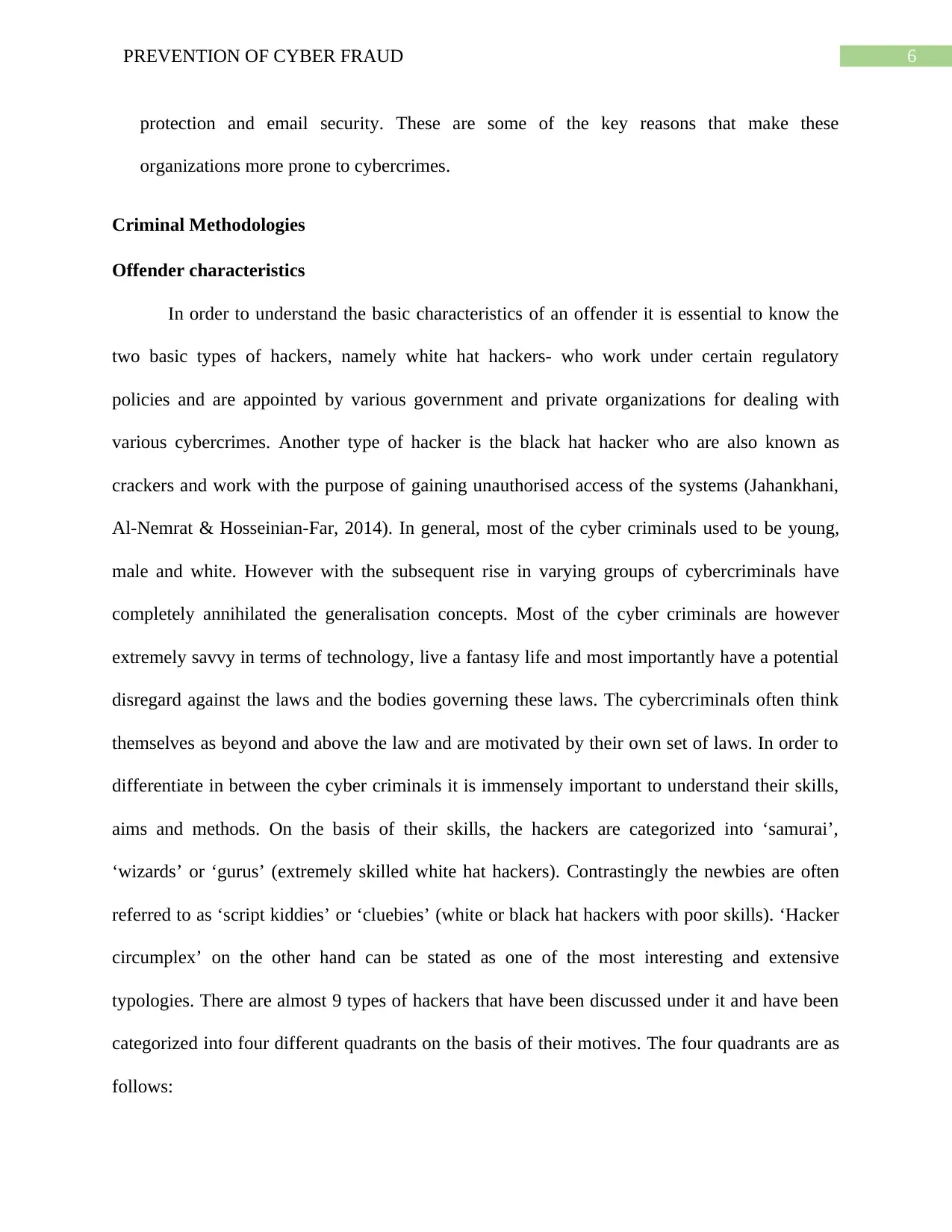
6PREVENTION OF CYBER FRAUD
protection and email security. These are some of the key reasons that make these
organizations more prone to cybercrimes.
Criminal Methodologies
Offender characteristics
In order to understand the basic characteristics of an offender it is essential to know the
two basic types of hackers, namely white hat hackers- who work under certain regulatory
policies and are appointed by various government and private organizations for dealing with
various cybercrimes. Another type of hacker is the black hat hacker who are also known as
crackers and work with the purpose of gaining unauthorised access of the systems (Jahankhani,
Al-Nemrat & Hosseinian-Far, 2014). In general, most of the cyber criminals used to be young,
male and white. However with the subsequent rise in varying groups of cybercriminals have
completely annihilated the generalisation concepts. Most of the cyber criminals are however
extremely savvy in terms of technology, live a fantasy life and most importantly have a potential
disregard against the laws and the bodies governing these laws. The cybercriminals often think
themselves as beyond and above the law and are motivated by their own set of laws. In order to
differentiate in between the cyber criminals it is immensely important to understand their skills,
aims and methods. On the basis of their skills, the hackers are categorized into ‘samurai’,
‘wizards’ or ‘gurus’ (extremely skilled white hat hackers). Contrastingly the newbies are often
referred to as ‘script kiddies’ or ‘cluebies’ (white or black hat hackers with poor skills). ‘Hacker
circumplex’ on the other hand can be stated as one of the most interesting and extensive
typologies. There are almost 9 types of hackers that have been discussed under it and have been
categorized into four different quadrants on the basis of their motives. The four quadrants are as
follows:
protection and email security. These are some of the key reasons that make these
organizations more prone to cybercrimes.
Criminal Methodologies
Offender characteristics
In order to understand the basic characteristics of an offender it is essential to know the
two basic types of hackers, namely white hat hackers- who work under certain regulatory
policies and are appointed by various government and private organizations for dealing with
various cybercrimes. Another type of hacker is the black hat hacker who are also known as
crackers and work with the purpose of gaining unauthorised access of the systems (Jahankhani,
Al-Nemrat & Hosseinian-Far, 2014). In general, most of the cyber criminals used to be young,
male and white. However with the subsequent rise in varying groups of cybercriminals have
completely annihilated the generalisation concepts. Most of the cyber criminals are however
extremely savvy in terms of technology, live a fantasy life and most importantly have a potential
disregard against the laws and the bodies governing these laws. The cybercriminals often think
themselves as beyond and above the law and are motivated by their own set of laws. In order to
differentiate in between the cyber criminals it is immensely important to understand their skills,
aims and methods. On the basis of their skills, the hackers are categorized into ‘samurai’,
‘wizards’ or ‘gurus’ (extremely skilled white hat hackers). Contrastingly the newbies are often
referred to as ‘script kiddies’ or ‘cluebies’ (white or black hat hackers with poor skills). ‘Hacker
circumplex’ on the other hand can be stated as one of the most interesting and extensive
typologies. There are almost 9 types of hackers that have been discussed under it and have been
categorized into four different quadrants on the basis of their motives. The four quadrants are as
follows:
Paraphrase This Document
Need a fresh take? Get an instant paraphrase of this document with our AI Paraphraser
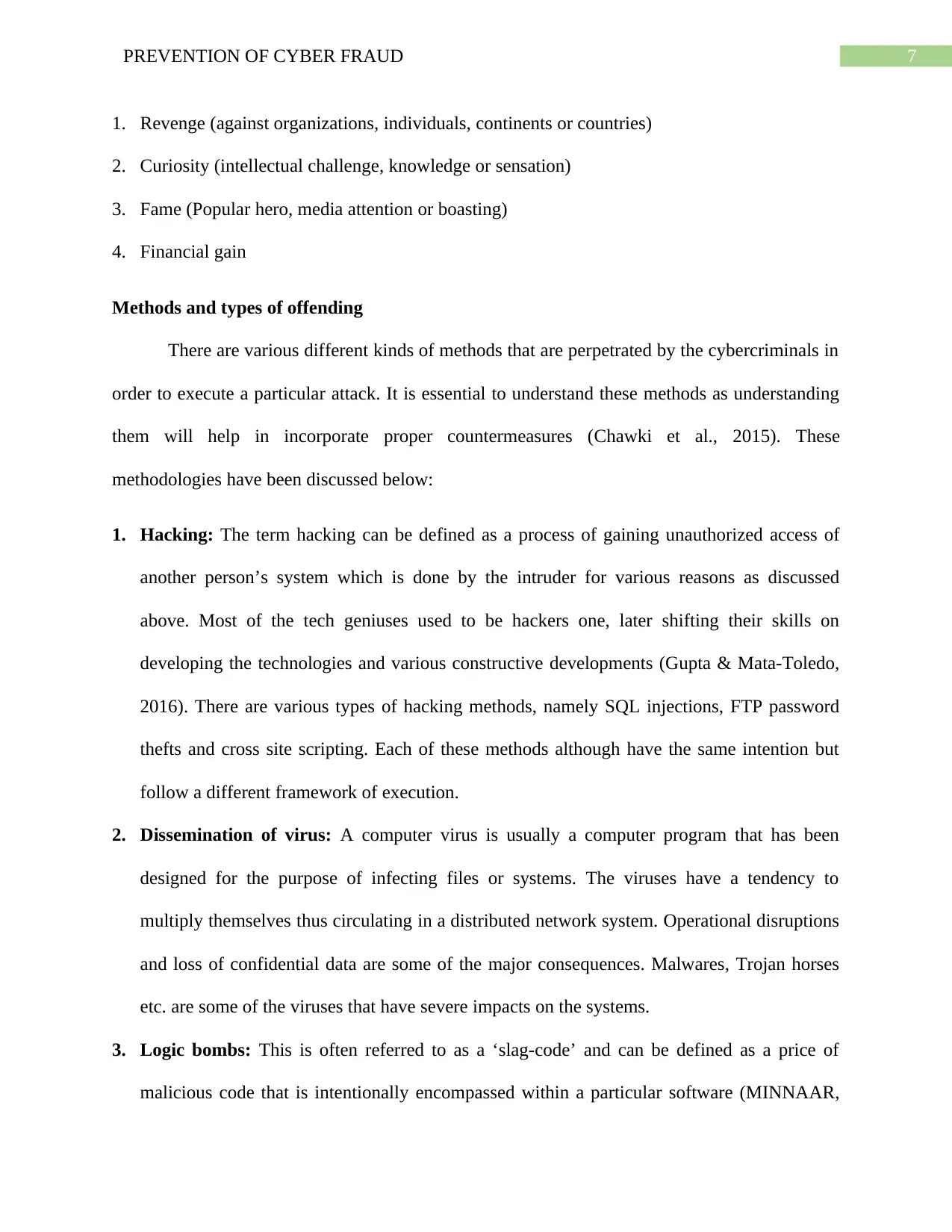
7PREVENTION OF CYBER FRAUD
1. Revenge (against organizations, individuals, continents or countries)
2. Curiosity (intellectual challenge, knowledge or sensation)
3. Fame (Popular hero, media attention or boasting)
4. Financial gain
Methods and types of offending
There are various different kinds of methods that are perpetrated by the cybercriminals in
order to execute a particular attack. It is essential to understand these methods as understanding
them will help in incorporate proper countermeasures (Chawki et al., 2015). These
methodologies have been discussed below:
1. Hacking: The term hacking can be defined as a process of gaining unauthorized access of
another person’s system which is done by the intruder for various reasons as discussed
above. Most of the tech geniuses used to be hackers one, later shifting their skills on
developing the technologies and various constructive developments (Gupta & Mata-Toledo,
2016). There are various types of hacking methods, namely SQL injections, FTP password
thefts and cross site scripting. Each of these methods although have the same intention but
follow a different framework of execution.
2. Dissemination of virus: A computer virus is usually a computer program that has been
designed for the purpose of infecting files or systems. The viruses have a tendency to
multiply themselves thus circulating in a distributed network system. Operational disruptions
and loss of confidential data are some of the major consequences. Malwares, Trojan horses
etc. are some of the viruses that have severe impacts on the systems.
3. Logic bombs: This is often referred to as a ‘slag-code’ and can be defined as a price of
malicious code that is intentionally encompassed within a particular software (MINNAAR,
1. Revenge (against organizations, individuals, continents or countries)
2. Curiosity (intellectual challenge, knowledge or sensation)
3. Fame (Popular hero, media attention or boasting)
4. Financial gain
Methods and types of offending
There are various different kinds of methods that are perpetrated by the cybercriminals in
order to execute a particular attack. It is essential to understand these methods as understanding
them will help in incorporate proper countermeasures (Chawki et al., 2015). These
methodologies have been discussed below:
1. Hacking: The term hacking can be defined as a process of gaining unauthorized access of
another person’s system which is done by the intruder for various reasons as discussed
above. Most of the tech geniuses used to be hackers one, later shifting their skills on
developing the technologies and various constructive developments (Gupta & Mata-Toledo,
2016). There are various types of hacking methods, namely SQL injections, FTP password
thefts and cross site scripting. Each of these methods although have the same intention but
follow a different framework of execution.
2. Dissemination of virus: A computer virus is usually a computer program that has been
designed for the purpose of infecting files or systems. The viruses have a tendency to
multiply themselves thus circulating in a distributed network system. Operational disruptions
and loss of confidential data are some of the major consequences. Malwares, Trojan horses
etc. are some of the viruses that have severe impacts on the systems.
3. Logic bombs: This is often referred to as a ‘slag-code’ and can be defined as a price of
malicious code that is intentionally encompassed within a particular software (MINNAAR,
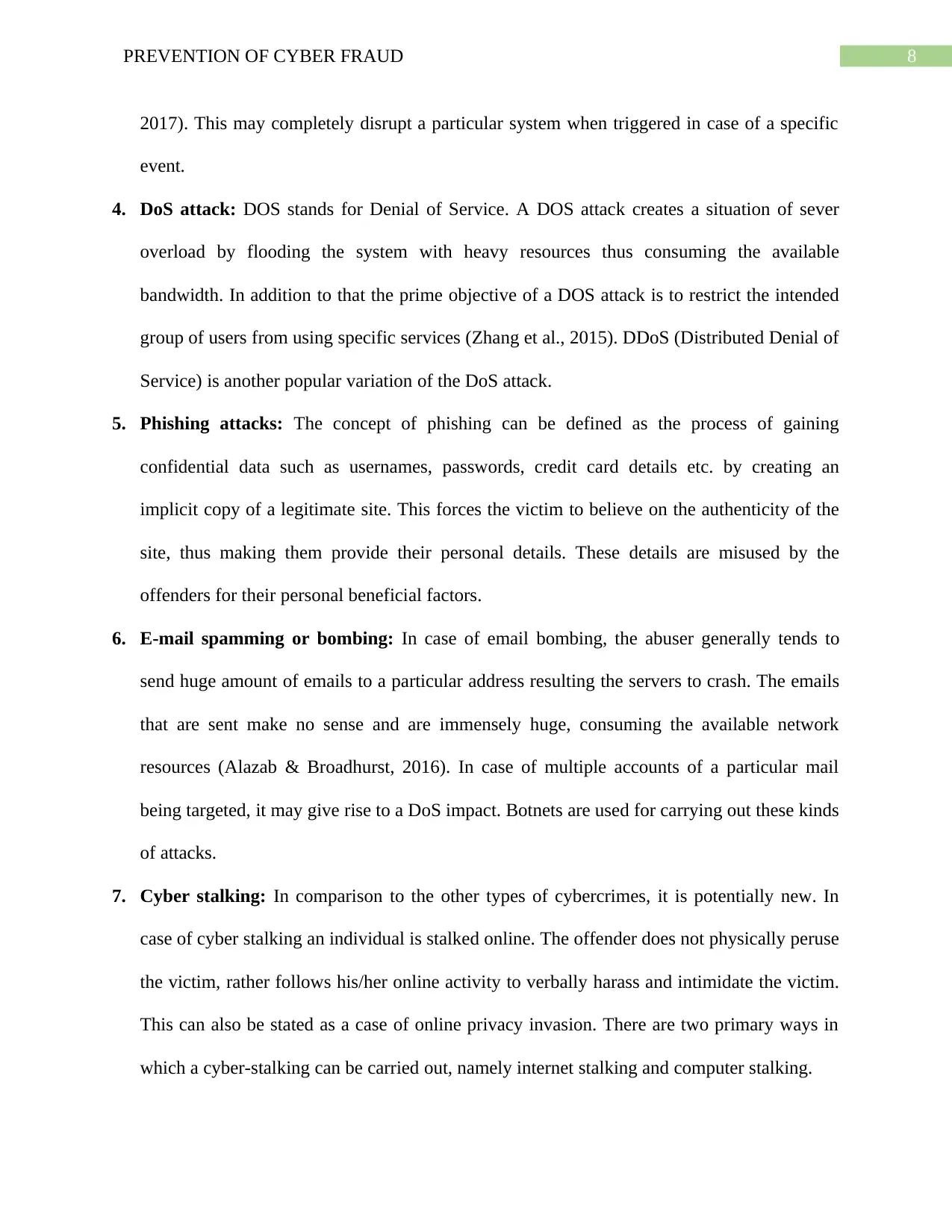
8PREVENTION OF CYBER FRAUD
2017). This may completely disrupt a particular system when triggered in case of a specific
event.
4. DoS attack: DOS stands for Denial of Service. A DOS attack creates a situation of sever
overload by flooding the system with heavy resources thus consuming the available
bandwidth. In addition to that the prime objective of a DOS attack is to restrict the intended
group of users from using specific services (Zhang et al., 2015). DDoS (Distributed Denial of
Service) is another popular variation of the DoS attack.
5. Phishing attacks: The concept of phishing can be defined as the process of gaining
confidential data such as usernames, passwords, credit card details etc. by creating an
implicit copy of a legitimate site. This forces the victim to believe on the authenticity of the
site, thus making them provide their personal details. These details are misused by the
offenders for their personal beneficial factors.
6. E-mail spamming or bombing: In case of email bombing, the abuser generally tends to
send huge amount of emails to a particular address resulting the servers to crash. The emails
that are sent make no sense and are immensely huge, consuming the available network
resources (Alazab & Broadhurst, 2016). In case of multiple accounts of a particular mail
being targeted, it may give rise to a DoS impact. Botnets are used for carrying out these kinds
of attacks.
7. Cyber stalking: In comparison to the other types of cybercrimes, it is potentially new. In
case of cyber stalking an individual is stalked online. The offender does not physically peruse
the victim, rather follows his/her online activity to verbally harass and intimidate the victim.
This can also be stated as a case of online privacy invasion. There are two primary ways in
which a cyber-stalking can be carried out, namely internet stalking and computer stalking.
2017). This may completely disrupt a particular system when triggered in case of a specific
event.
4. DoS attack: DOS stands for Denial of Service. A DOS attack creates a situation of sever
overload by flooding the system with heavy resources thus consuming the available
bandwidth. In addition to that the prime objective of a DOS attack is to restrict the intended
group of users from using specific services (Zhang et al., 2015). DDoS (Distributed Denial of
Service) is another popular variation of the DoS attack.
5. Phishing attacks: The concept of phishing can be defined as the process of gaining
confidential data such as usernames, passwords, credit card details etc. by creating an
implicit copy of a legitimate site. This forces the victim to believe on the authenticity of the
site, thus making them provide their personal details. These details are misused by the
offenders for their personal beneficial factors.
6. E-mail spamming or bombing: In case of email bombing, the abuser generally tends to
send huge amount of emails to a particular address resulting the servers to crash. The emails
that are sent make no sense and are immensely huge, consuming the available network
resources (Alazab & Broadhurst, 2016). In case of multiple accounts of a particular mail
being targeted, it may give rise to a DoS impact. Botnets are used for carrying out these kinds
of attacks.
7. Cyber stalking: In comparison to the other types of cybercrimes, it is potentially new. In
case of cyber stalking an individual is stalked online. The offender does not physically peruse
the victim, rather follows his/her online activity to verbally harass and intimidate the victim.
This can also be stated as a case of online privacy invasion. There are two primary ways in
which a cyber-stalking can be carried out, namely internet stalking and computer stalking.

9PREVENTION OF CYBER FRAUD
8. Web jacking: The term ‘web-jacking’ has been derived from ‘hijacking’. In this case the
offender uses a fraudulent way for the purpose of gaining control over a particular website.
This allows the offender to completely alter the content of the site and encompass something
of his personal interest (Sharma, Doshi & Prajapati, 2016). The site owner no longer has the
control of the site allowing the attacker to use it for is personal benefits.
9. Data diddling: The process of data diddling involves alteration of data by the offender
during or before the data entry process and turning it back after the data processing. This
technique allows the offender to modify data in terms of expected output and is often very
had to track.
10. Credit card frauds and identity thefts: The process of identity theft takes place when the
offender impersonates to be someone else thus accessing the victim’s vital resources, such as
credit card details. The motive behind an identity theft can be far greater than accessing
personal credentials (Moore, 2014). Various other kinds of crimes can also be committed by
the offender or imposter. This has severe impacts on an individual or an organization.
Victimization
Victim characteristics
When it comes to cybercrimes, there are certain characteristics that can be seen in the
victims. These characteristic traits make them more prone to cyber-attacks. The offender misuses
these traits for gaining personal benefits (Näsi et al., 2015). These characteristic traits have been
discussed below:
1. Conscientiousness: This particular trait of the victim can be categorized by high attention
and concentration to the specific details. The people who have this kind of trait are expected
to have a high sense of self control and are generally organized. There is a positive
8. Web jacking: The term ‘web-jacking’ has been derived from ‘hijacking’. In this case the
offender uses a fraudulent way for the purpose of gaining control over a particular website.
This allows the offender to completely alter the content of the site and encompass something
of his personal interest (Sharma, Doshi & Prajapati, 2016). The site owner no longer has the
control of the site allowing the attacker to use it for is personal benefits.
9. Data diddling: The process of data diddling involves alteration of data by the offender
during or before the data entry process and turning it back after the data processing. This
technique allows the offender to modify data in terms of expected output and is often very
had to track.
10. Credit card frauds and identity thefts: The process of identity theft takes place when the
offender impersonates to be someone else thus accessing the victim’s vital resources, such as
credit card details. The motive behind an identity theft can be far greater than accessing
personal credentials (Moore, 2014). Various other kinds of crimes can also be committed by
the offender or imposter. This has severe impacts on an individual or an organization.
Victimization
Victim characteristics
When it comes to cybercrimes, there are certain characteristics that can be seen in the
victims. These characteristic traits make them more prone to cyber-attacks. The offender misuses
these traits for gaining personal benefits (Näsi et al., 2015). These characteristic traits have been
discussed below:
1. Conscientiousness: This particular trait of the victim can be categorized by high attention
and concentration to the specific details. The people who have this kind of trait are expected
to have a high sense of self control and are generally organized. There is a positive
Secure Best Marks with AI Grader
Need help grading? Try our AI Grader for instant feedback on your assignments.
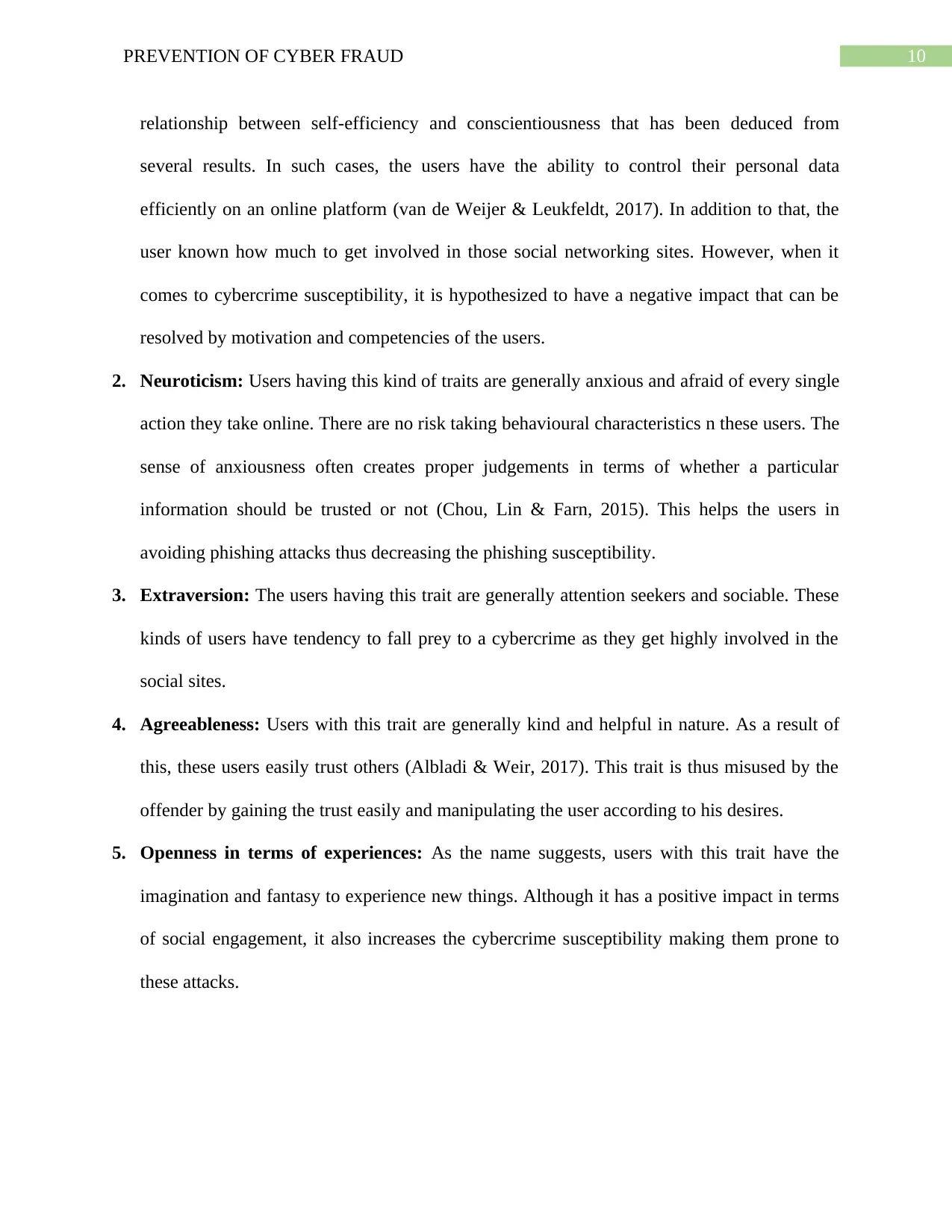
10PREVENTION OF CYBER FRAUD
relationship between self-efficiency and conscientiousness that has been deduced from
several results. In such cases, the users have the ability to control their personal data
efficiently on an online platform (van de Weijer & Leukfeldt, 2017). In addition to that, the
user known how much to get involved in those social networking sites. However, when it
comes to cybercrime susceptibility, it is hypothesized to have a negative impact that can be
resolved by motivation and competencies of the users.
2. Neuroticism: Users having this kind of traits are generally anxious and afraid of every single
action they take online. There are no risk taking behavioural characteristics n these users. The
sense of anxiousness often creates proper judgements in terms of whether a particular
information should be trusted or not (Chou, Lin & Farn, 2015). This helps the users in
avoiding phishing attacks thus decreasing the phishing susceptibility.
3. Extraversion: The users having this trait are generally attention seekers and sociable. These
kinds of users have tendency to fall prey to a cybercrime as they get highly involved in the
social sites.
4. Agreeableness: Users with this trait are generally kind and helpful in nature. As a result of
this, these users easily trust others (Albladi & Weir, 2017). This trait is thus misused by the
offender by gaining the trust easily and manipulating the user according to his desires.
5. Openness in terms of experiences: As the name suggests, users with this trait have the
imagination and fantasy to experience new things. Although it has a positive impact in terms
of social engagement, it also increases the cybercrime susceptibility making them prone to
these attacks.
relationship between self-efficiency and conscientiousness that has been deduced from
several results. In such cases, the users have the ability to control their personal data
efficiently on an online platform (van de Weijer & Leukfeldt, 2017). In addition to that, the
user known how much to get involved in those social networking sites. However, when it
comes to cybercrime susceptibility, it is hypothesized to have a negative impact that can be
resolved by motivation and competencies of the users.
2. Neuroticism: Users having this kind of traits are generally anxious and afraid of every single
action they take online. There are no risk taking behavioural characteristics n these users. The
sense of anxiousness often creates proper judgements in terms of whether a particular
information should be trusted or not (Chou, Lin & Farn, 2015). This helps the users in
avoiding phishing attacks thus decreasing the phishing susceptibility.
3. Extraversion: The users having this trait are generally attention seekers and sociable. These
kinds of users have tendency to fall prey to a cybercrime as they get highly involved in the
social sites.
4. Agreeableness: Users with this trait are generally kind and helpful in nature. As a result of
this, these users easily trust others (Albladi & Weir, 2017). This trait is thus misused by the
offender by gaining the trust easily and manipulating the user according to his desires.
5. Openness in terms of experiences: As the name suggests, users with this trait have the
imagination and fantasy to experience new things. Although it has a positive impact in terms
of social engagement, it also increases the cybercrime susceptibility making them prone to
these attacks.
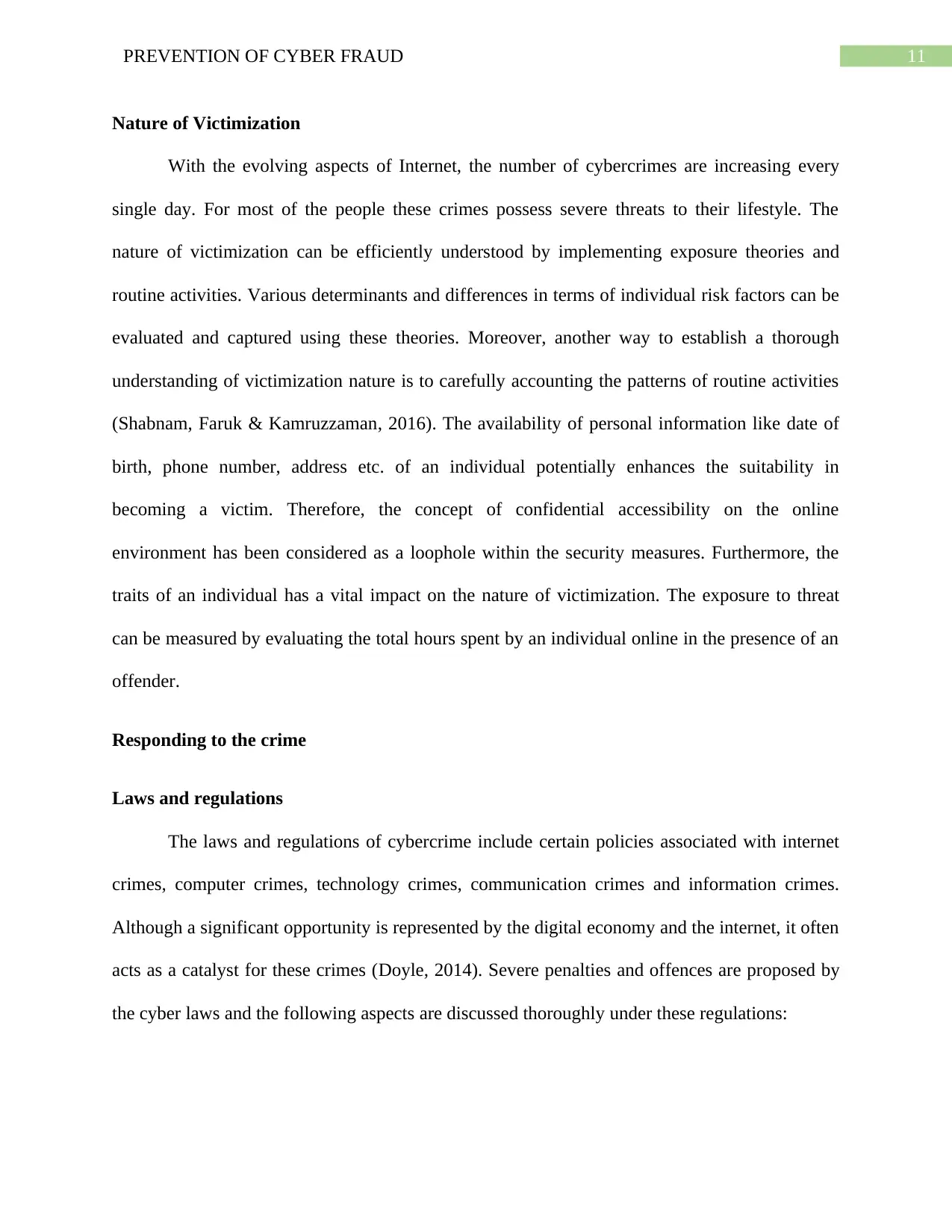
11PREVENTION OF CYBER FRAUD
Nature of Victimization
With the evolving aspects of Internet, the number of cybercrimes are increasing every
single day. For most of the people these crimes possess severe threats to their lifestyle. The
nature of victimization can be efficiently understood by implementing exposure theories and
routine activities. Various determinants and differences in terms of individual risk factors can be
evaluated and captured using these theories. Moreover, another way to establish a thorough
understanding of victimization nature is to carefully accounting the patterns of routine activities
(Shabnam, Faruk & Kamruzzaman, 2016). The availability of personal information like date of
birth, phone number, address etc. of an individual potentially enhances the suitability in
becoming a victim. Therefore, the concept of confidential accessibility on the online
environment has been considered as a loophole within the security measures. Furthermore, the
traits of an individual has a vital impact on the nature of victimization. The exposure to threat
can be measured by evaluating the total hours spent by an individual online in the presence of an
offender.
Responding to the crime
Laws and regulations
The laws and regulations of cybercrime include certain policies associated with internet
crimes, computer crimes, technology crimes, communication crimes and information crimes.
Although a significant opportunity is represented by the digital economy and the internet, it often
acts as a catalyst for these crimes (Doyle, 2014). Severe penalties and offences are proposed by
the cyber laws and the following aspects are discussed thoroughly under these regulations:
Nature of Victimization
With the evolving aspects of Internet, the number of cybercrimes are increasing every
single day. For most of the people these crimes possess severe threats to their lifestyle. The
nature of victimization can be efficiently understood by implementing exposure theories and
routine activities. Various determinants and differences in terms of individual risk factors can be
evaluated and captured using these theories. Moreover, another way to establish a thorough
understanding of victimization nature is to carefully accounting the patterns of routine activities
(Shabnam, Faruk & Kamruzzaman, 2016). The availability of personal information like date of
birth, phone number, address etc. of an individual potentially enhances the suitability in
becoming a victim. Therefore, the concept of confidential accessibility on the online
environment has been considered as a loophole within the security measures. Furthermore, the
traits of an individual has a vital impact on the nature of victimization. The exposure to threat
can be measured by evaluating the total hours spent by an individual online in the presence of an
offender.
Responding to the crime
Laws and regulations
The laws and regulations of cybercrime include certain policies associated with internet
crimes, computer crimes, technology crimes, communication crimes and information crimes.
Although a significant opportunity is represented by the digital economy and the internet, it often
acts as a catalyst for these crimes (Doyle, 2014). Severe penalties and offences are proposed by
the cyber laws and the following aspects are discussed thoroughly under these regulations:
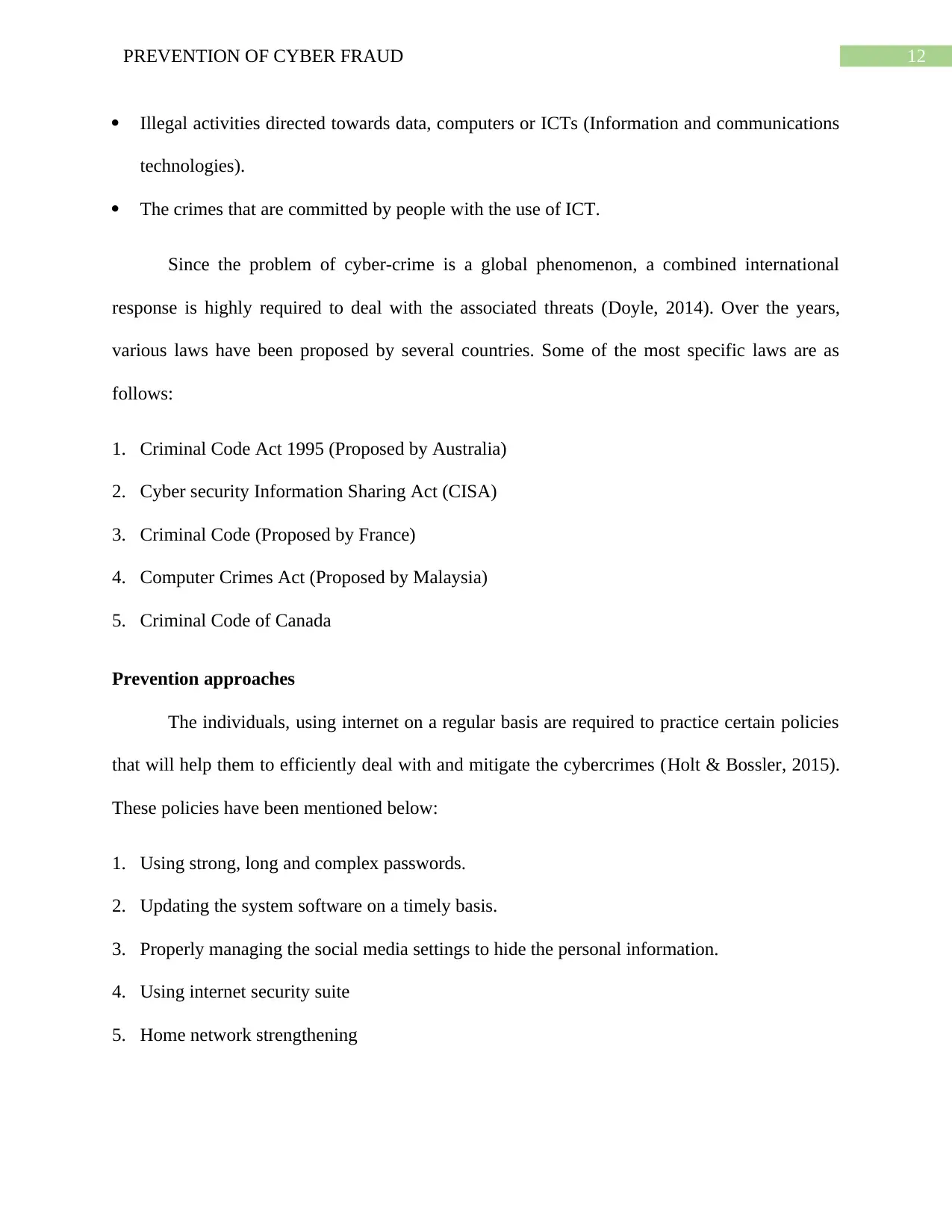
12PREVENTION OF CYBER FRAUD
Illegal activities directed towards data, computers or ICTs (Information and communications
technologies).
The crimes that are committed by people with the use of ICT.
Since the problem of cyber-crime is a global phenomenon, a combined international
response is highly required to deal with the associated threats (Doyle, 2014). Over the years,
various laws have been proposed by several countries. Some of the most specific laws are as
follows:
1. Criminal Code Act 1995 (Proposed by Australia)
2. Cyber security Information Sharing Act (CISA)
3. Criminal Code (Proposed by France)
4. Computer Crimes Act (Proposed by Malaysia)
5. Criminal Code of Canada
Prevention approaches
The individuals, using internet on a regular basis are required to practice certain policies
that will help them to efficiently deal with and mitigate the cybercrimes (Holt & Bossler, 2015).
These policies have been mentioned below:
1. Using strong, long and complex passwords.
2. Updating the system software on a timely basis.
3. Properly managing the social media settings to hide the personal information.
4. Using internet security suite
5. Home network strengthening
Illegal activities directed towards data, computers or ICTs (Information and communications
technologies).
The crimes that are committed by people with the use of ICT.
Since the problem of cyber-crime is a global phenomenon, a combined international
response is highly required to deal with the associated threats (Doyle, 2014). Over the years,
various laws have been proposed by several countries. Some of the most specific laws are as
follows:
1. Criminal Code Act 1995 (Proposed by Australia)
2. Cyber security Information Sharing Act (CISA)
3. Criminal Code (Proposed by France)
4. Computer Crimes Act (Proposed by Malaysia)
5. Criminal Code of Canada
Prevention approaches
The individuals, using internet on a regular basis are required to practice certain policies
that will help them to efficiently deal with and mitigate the cybercrimes (Holt & Bossler, 2015).
These policies have been mentioned below:
1. Using strong, long and complex passwords.
2. Updating the system software on a timely basis.
3. Properly managing the social media settings to hide the personal information.
4. Using internet security suite
5. Home network strengthening
Paraphrase This Document
Need a fresh take? Get an instant paraphrase of this document with our AI Paraphraser
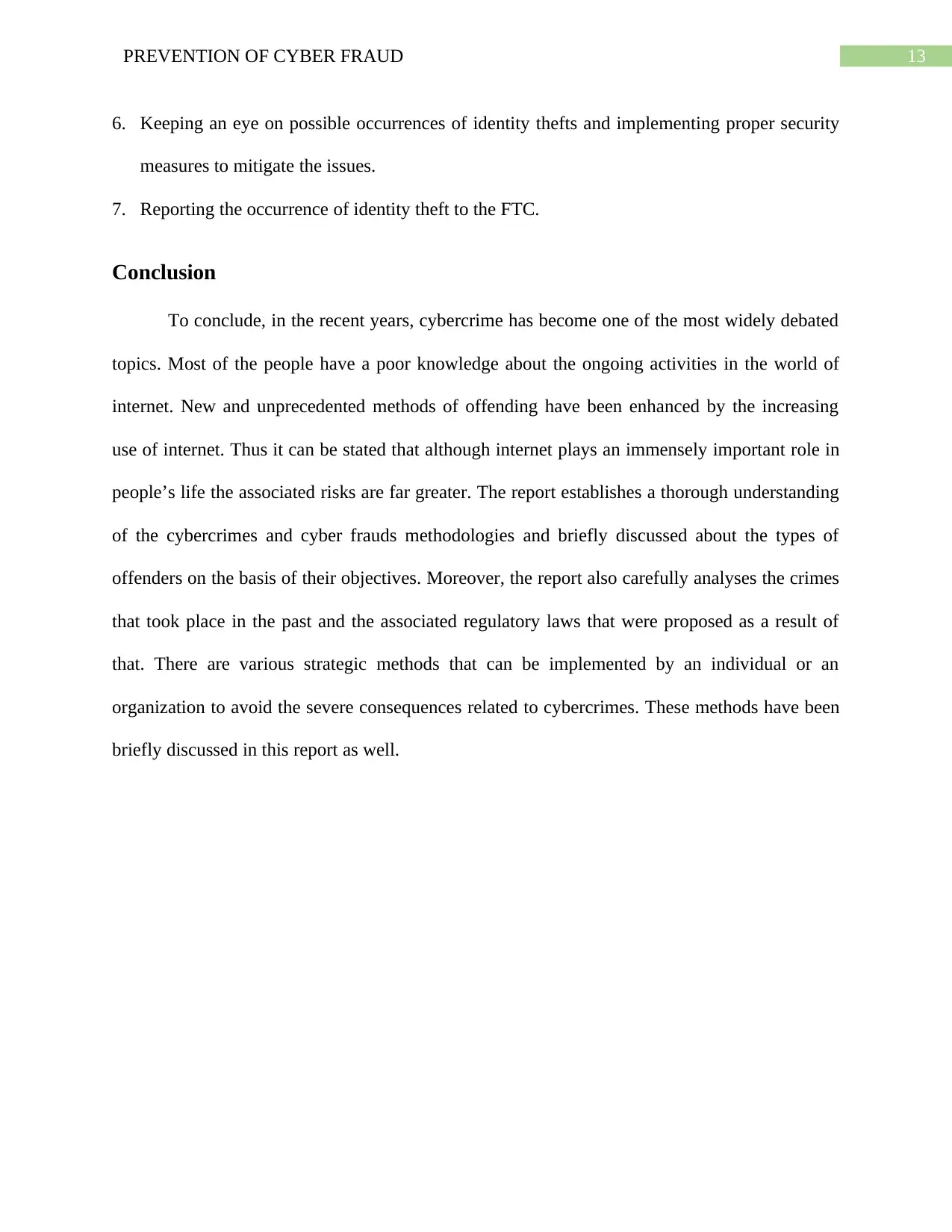
13PREVENTION OF CYBER FRAUD
6. Keeping an eye on possible occurrences of identity thefts and implementing proper security
measures to mitigate the issues.
7. Reporting the occurrence of identity theft to the FTC.
Conclusion
To conclude, in the recent years, cybercrime has become one of the most widely debated
topics. Most of the people have a poor knowledge about the ongoing activities in the world of
internet. New and unprecedented methods of offending have been enhanced by the increasing
use of internet. Thus it can be stated that although internet plays an immensely important role in
people’s life the associated risks are far greater. The report establishes a thorough understanding
of the cybercrimes and cyber frauds methodologies and briefly discussed about the types of
offenders on the basis of their objectives. Moreover, the report also carefully analyses the crimes
that took place in the past and the associated regulatory laws that were proposed as a result of
that. There are various strategic methods that can be implemented by an individual or an
organization to avoid the severe consequences related to cybercrimes. These methods have been
briefly discussed in this report as well.
6. Keeping an eye on possible occurrences of identity thefts and implementing proper security
measures to mitigate the issues.
7. Reporting the occurrence of identity theft to the FTC.
Conclusion
To conclude, in the recent years, cybercrime has become one of the most widely debated
topics. Most of the people have a poor knowledge about the ongoing activities in the world of
internet. New and unprecedented methods of offending have been enhanced by the increasing
use of internet. Thus it can be stated that although internet plays an immensely important role in
people’s life the associated risks are far greater. The report establishes a thorough understanding
of the cybercrimes and cyber frauds methodologies and briefly discussed about the types of
offenders on the basis of their objectives. Moreover, the report also carefully analyses the crimes
that took place in the past and the associated regulatory laws that were proposed as a result of
that. There are various strategic methods that can be implemented by an individual or an
organization to avoid the severe consequences related to cybercrimes. These methods have been
briefly discussed in this report as well.
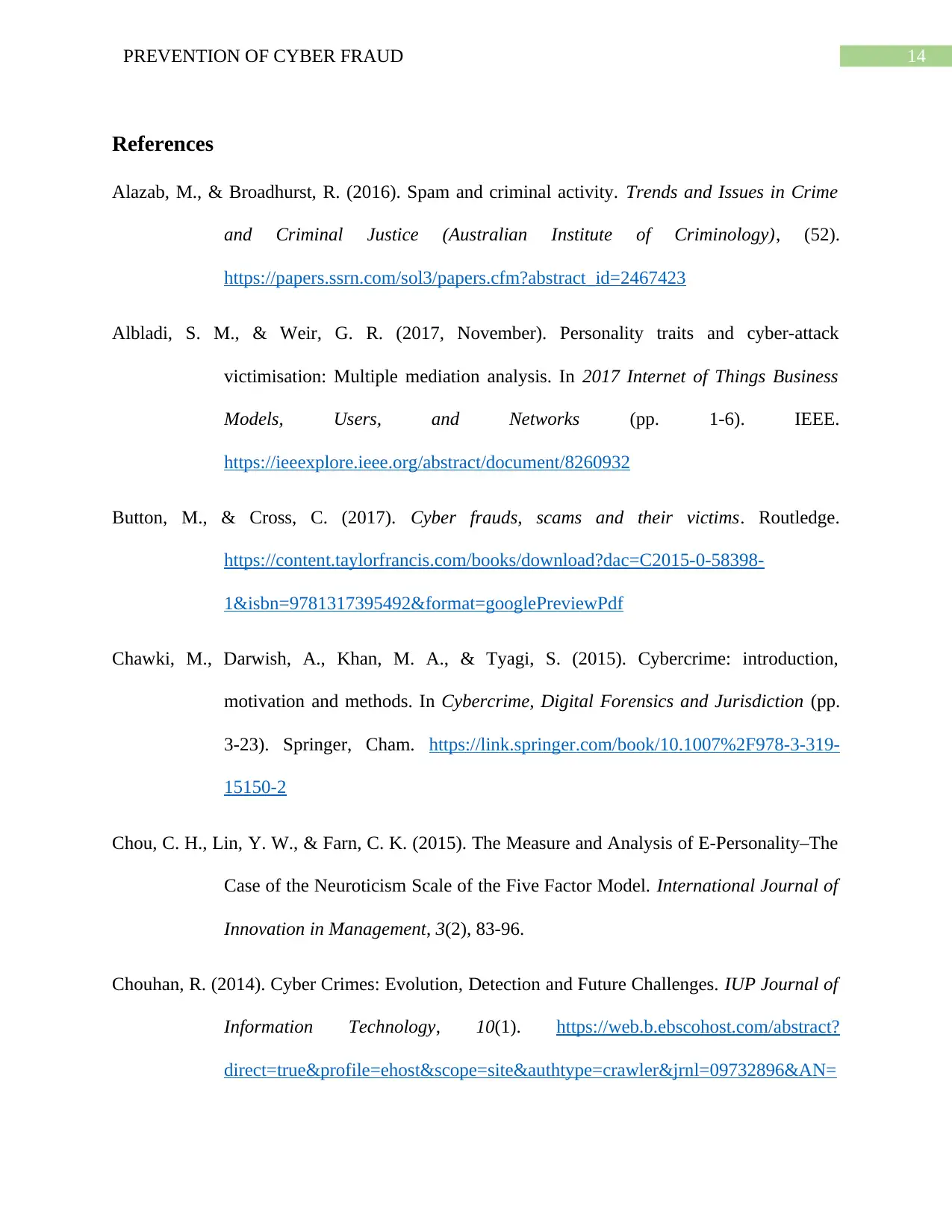
14PREVENTION OF CYBER FRAUD
References
Alazab, M., & Broadhurst, R. (2016). Spam and criminal activity. Trends and Issues in Crime
and Criminal Justice (Australian Institute of Criminology), (52).
https://papers.ssrn.com/sol3/papers.cfm?abstract_id=2467423
Albladi, S. M., & Weir, G. R. (2017, November). Personality traits and cyber-attack
victimisation: Multiple mediation analysis. In 2017 Internet of Things Business
Models, Users, and Networks (pp. 1-6). IEEE.
https://ieeexplore.ieee.org/abstract/document/8260932
Button, M., & Cross, C. (2017). Cyber frauds, scams and their victims. Routledge.
https://content.taylorfrancis.com/books/download?dac=C2015-0-58398-
1&isbn=9781317395492&format=googlePreviewPdf
Chawki, M., Darwish, A., Khan, M. A., & Tyagi, S. (2015). Cybercrime: introduction,
motivation and methods. In Cybercrime, Digital Forensics and Jurisdiction (pp.
3-23). Springer, Cham. https://link.springer.com/book/10.1007%2F978-3-319-
15150-2
Chou, C. H., Lin, Y. W., & Farn, C. K. (2015). The Measure and Analysis of E-Personality–The
Case of the Neuroticism Scale of the Five Factor Model. International Journal of
Innovation in Management, 3(2), 83-96.
Chouhan, R. (2014). Cyber Crimes: Evolution, Detection and Future Challenges. IUP Journal of
Information Technology, 10(1). https://web.b.ebscohost.com/abstract?
direct=true&profile=ehost&scope=site&authtype=crawler&jrnl=09732896&AN=
References
Alazab, M., & Broadhurst, R. (2016). Spam and criminal activity. Trends and Issues in Crime
and Criminal Justice (Australian Institute of Criminology), (52).
https://papers.ssrn.com/sol3/papers.cfm?abstract_id=2467423
Albladi, S. M., & Weir, G. R. (2017, November). Personality traits and cyber-attack
victimisation: Multiple mediation analysis. In 2017 Internet of Things Business
Models, Users, and Networks (pp. 1-6). IEEE.
https://ieeexplore.ieee.org/abstract/document/8260932
Button, M., & Cross, C. (2017). Cyber frauds, scams and their victims. Routledge.
https://content.taylorfrancis.com/books/download?dac=C2015-0-58398-
1&isbn=9781317395492&format=googlePreviewPdf
Chawki, M., Darwish, A., Khan, M. A., & Tyagi, S. (2015). Cybercrime: introduction,
motivation and methods. In Cybercrime, Digital Forensics and Jurisdiction (pp.
3-23). Springer, Cham. https://link.springer.com/book/10.1007%2F978-3-319-
15150-2
Chou, C. H., Lin, Y. W., & Farn, C. K. (2015). The Measure and Analysis of E-Personality–The
Case of the Neuroticism Scale of the Five Factor Model. International Journal of
Innovation in Management, 3(2), 83-96.
Chouhan, R. (2014). Cyber Crimes: Evolution, Detection and Future Challenges. IUP Journal of
Information Technology, 10(1). https://web.b.ebscohost.com/abstract?
direct=true&profile=ehost&scope=site&authtype=crawler&jrnl=09732896&AN=
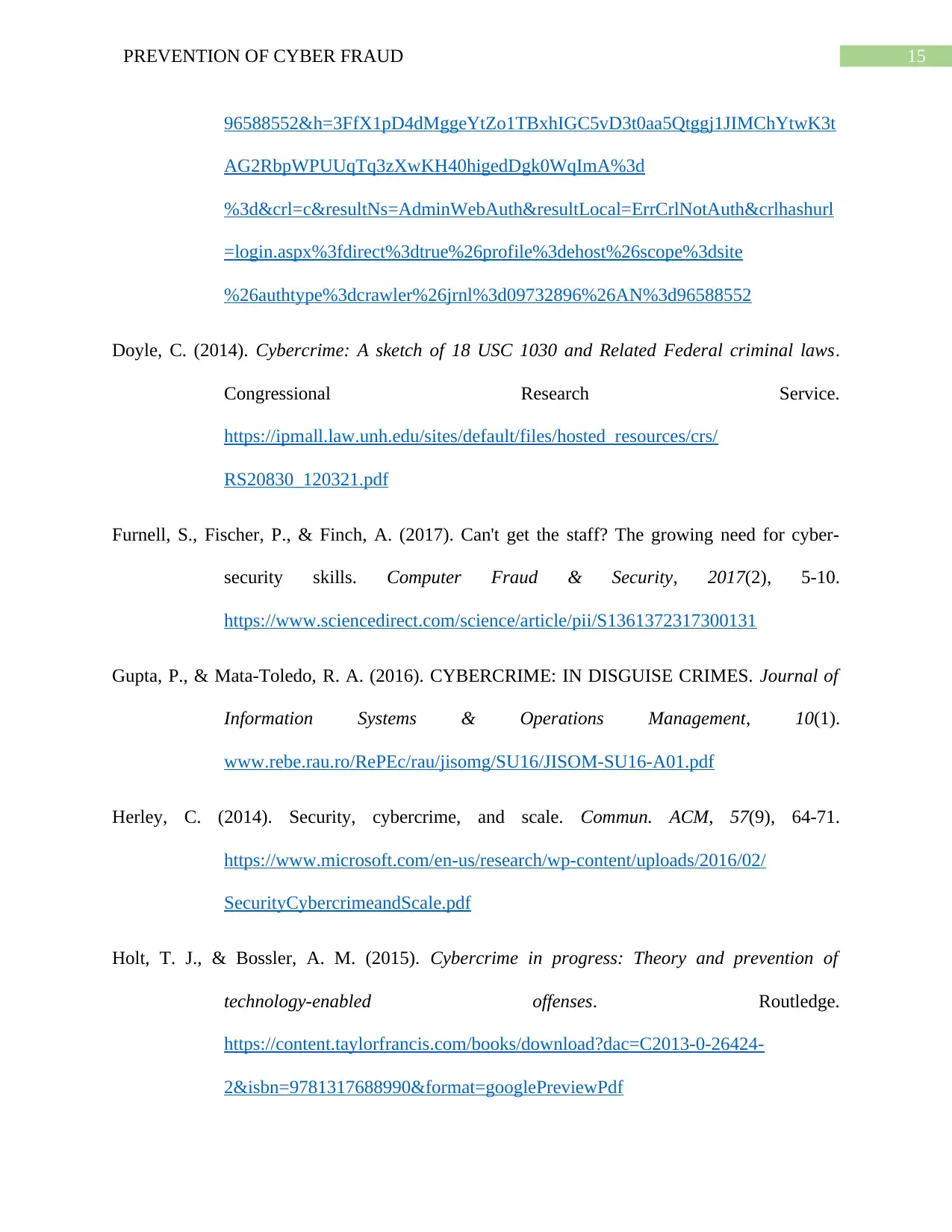
15PREVENTION OF CYBER FRAUD
96588552&h=3FfX1pD4dMggeYtZo1TBxhIGC5vD3t0aa5Qtggj1JIMChYtwK3t
AG2RbpWPUUqTq3zXwKH40higedDgk0WqImA%3d
%3d&crl=c&resultNs=AdminWebAuth&resultLocal=ErrCrlNotAuth&crlhashurl
=login.aspx%3fdirect%3dtrue%26profile%3dehost%26scope%3dsite
%26authtype%3dcrawler%26jrnl%3d09732896%26AN%3d96588552
Doyle, C. (2014). Cybercrime: A sketch of 18 USC 1030 and Related Federal criminal laws.
Congressional Research Service.
https://ipmall.law.unh.edu/sites/default/files/hosted_resources/crs/
RS20830_120321.pdf
Furnell, S., Fischer, P., & Finch, A. (2017). Can't get the staff? The growing need for cyber-
security skills. Computer Fraud & Security, 2017(2), 5-10.
https://www.sciencedirect.com/science/article/pii/S1361372317300131
Gupta, P., & Mata-Toledo, R. A. (2016). CYBERCRIME: IN DISGUISE CRIMES. Journal of
Information Systems & Operations Management, 10(1).
www.rebe.rau.ro/RePEc/rau/jisomg/SU16/JISOM-SU16-A01.pdf
Herley, C. (2014). Security, cybercrime, and scale. Commun. ACM, 57(9), 64-71.
https://www.microsoft.com/en-us/research/wp-content/uploads/2016/02/
SecurityCybercrimeandScale.pdf
Holt, T. J., & Bossler, A. M. (2015). Cybercrime in progress: Theory and prevention of
technology-enabled offenses. Routledge.
https://content.taylorfrancis.com/books/download?dac=C2013-0-26424-
2&isbn=9781317688990&format=googlePreviewPdf
96588552&h=3FfX1pD4dMggeYtZo1TBxhIGC5vD3t0aa5Qtggj1JIMChYtwK3t
AG2RbpWPUUqTq3zXwKH40higedDgk0WqImA%3d
%3d&crl=c&resultNs=AdminWebAuth&resultLocal=ErrCrlNotAuth&crlhashurl
=login.aspx%3fdirect%3dtrue%26profile%3dehost%26scope%3dsite
%26authtype%3dcrawler%26jrnl%3d09732896%26AN%3d96588552
Doyle, C. (2014). Cybercrime: A sketch of 18 USC 1030 and Related Federal criminal laws.
Congressional Research Service.
https://ipmall.law.unh.edu/sites/default/files/hosted_resources/crs/
RS20830_120321.pdf
Furnell, S., Fischer, P., & Finch, A. (2017). Can't get the staff? The growing need for cyber-
security skills. Computer Fraud & Security, 2017(2), 5-10.
https://www.sciencedirect.com/science/article/pii/S1361372317300131
Gupta, P., & Mata-Toledo, R. A. (2016). CYBERCRIME: IN DISGUISE CRIMES. Journal of
Information Systems & Operations Management, 10(1).
www.rebe.rau.ro/RePEc/rau/jisomg/SU16/JISOM-SU16-A01.pdf
Herley, C. (2014). Security, cybercrime, and scale. Commun. ACM, 57(9), 64-71.
https://www.microsoft.com/en-us/research/wp-content/uploads/2016/02/
SecurityCybercrimeandScale.pdf
Holt, T. J., & Bossler, A. M. (2015). Cybercrime in progress: Theory and prevention of
technology-enabled offenses. Routledge.
https://content.taylorfrancis.com/books/download?dac=C2013-0-26424-
2&isbn=9781317688990&format=googlePreviewPdf
Secure Best Marks with AI Grader
Need help grading? Try our AI Grader for instant feedback on your assignments.

16PREVENTION OF CYBER FRAUD
Jahankhani, H., Al-Nemrat, A., & Hosseinian-Far, A. (2014). Cybercrime classification and
characteristics. In Cyber Crime and Cyber Terrorism Investigator's Handbook
(pp. 149-164). Syngress.
https://www.sciencedirect.com/science/article/pii/B9780128007433000128
Levi, M. (2017). Assessing the trends, scale and nature of economic cybercrimes: overview and
issues. Crime, Law and Social Change, 67(1), 3-20.
https://link.springer.com/article/10.1007/s10611-016-9645-3
MINNAAR, A. (2017). Cybercrime, Cyberattacks, and Problems of Implementing
Organizational Cybersecurity. In Global Issues in Contemporary Policing (pp.
147-164). CRC Press.
https://www.taylorfrancis.com/books/e/9781315436975/chapters/10.1201/978131
5436975-17
Moore, R. (2014). Cybercrime: Investigating high-technology computer crime. Routledge.
https://content.taylorfrancis.com/books/download?dac=C2014-0-36898-
5&isbn=9781317522973&format=googlePreviewPdf
Näsi, M., Oksanen, A., Keipi, T., & Räsänen, P. (2015). Cybercrime victimization among young
people: a multi-nation study. Journal of Scandinavian Studies in Criminology and
Crime Prevention, 16(2), 203-210.
https://www.tandfonline.com/doi/abs/10.1080/14043858.2015.1046640
Rutkin, A., & Tugander, R. (2015). Coverage questions concerning cybercrimes. FDCC
Quarterly, 64(2), 114.
Jahankhani, H., Al-Nemrat, A., & Hosseinian-Far, A. (2014). Cybercrime classification and
characteristics. In Cyber Crime and Cyber Terrorism Investigator's Handbook
(pp. 149-164). Syngress.
https://www.sciencedirect.com/science/article/pii/B9780128007433000128
Levi, M. (2017). Assessing the trends, scale and nature of economic cybercrimes: overview and
issues. Crime, Law and Social Change, 67(1), 3-20.
https://link.springer.com/article/10.1007/s10611-016-9645-3
MINNAAR, A. (2017). Cybercrime, Cyberattacks, and Problems of Implementing
Organizational Cybersecurity. In Global Issues in Contemporary Policing (pp.
147-164). CRC Press.
https://www.taylorfrancis.com/books/e/9781315436975/chapters/10.1201/978131
5436975-17
Moore, R. (2014). Cybercrime: Investigating high-technology computer crime. Routledge.
https://content.taylorfrancis.com/books/download?dac=C2014-0-36898-
5&isbn=9781317522973&format=googlePreviewPdf
Näsi, M., Oksanen, A., Keipi, T., & Räsänen, P. (2015). Cybercrime victimization among young
people: a multi-nation study. Journal of Scandinavian Studies in Criminology and
Crime Prevention, 16(2), 203-210.
https://www.tandfonline.com/doi/abs/10.1080/14043858.2015.1046640
Rutkin, A., & Tugander, R. (2015). Coverage questions concerning cybercrimes. FDCC
Quarterly, 64(2), 114.
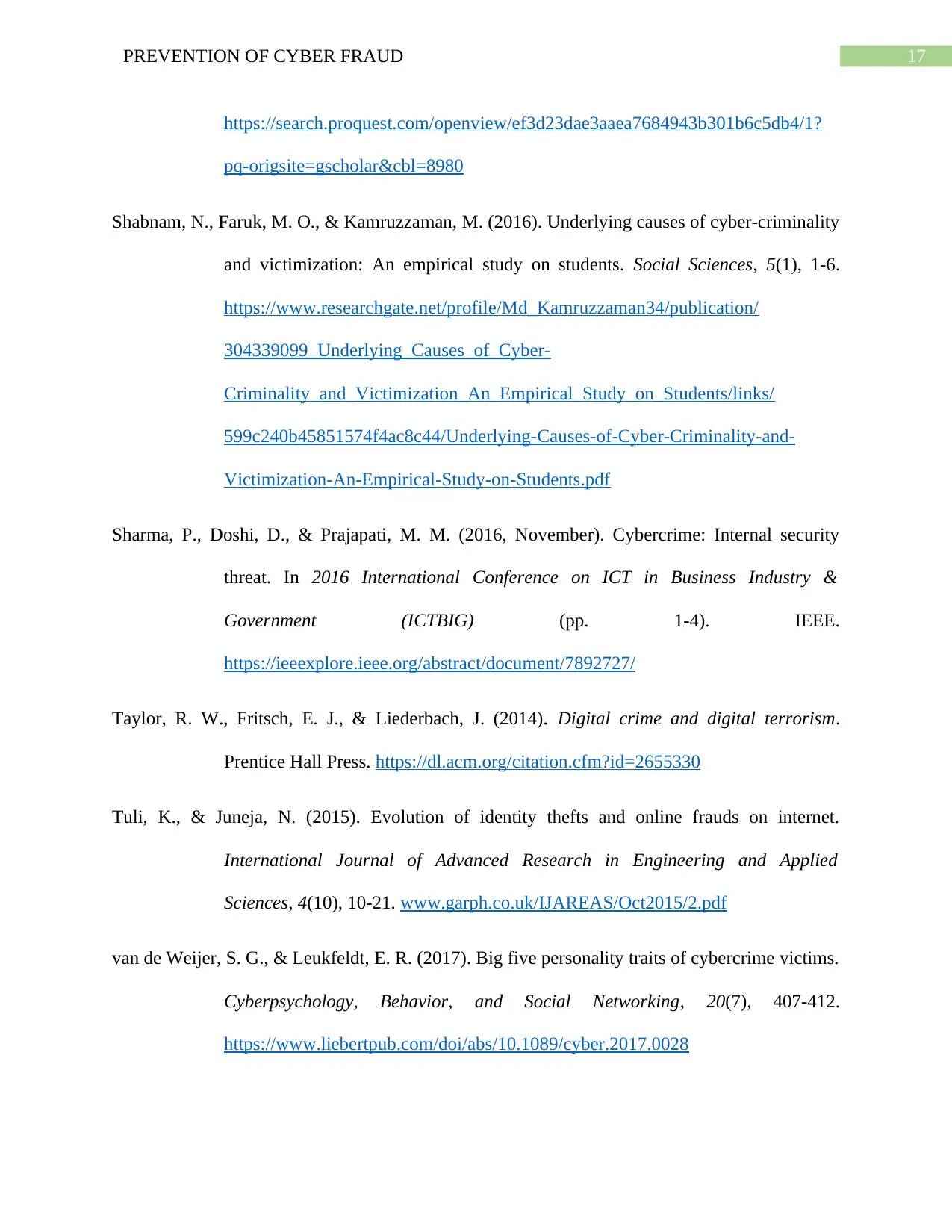
17PREVENTION OF CYBER FRAUD
https://search.proquest.com/openview/ef3d23dae3aaea7684943b301b6c5db4/1?
pq-origsite=gscholar&cbl=8980
Shabnam, N., Faruk, M. O., & Kamruzzaman, M. (2016). Underlying causes of cyber-criminality
and victimization: An empirical study on students. Social Sciences, 5(1), 1-6.
https://www.researchgate.net/profile/Md_Kamruzzaman34/publication/
304339099_Underlying_Causes_of_Cyber-
Criminality_and_Victimization_An_Empirical_Study_on_Students/links/
599c240b45851574f4ac8c44/Underlying-Causes-of-Cyber-Criminality-and-
Victimization-An-Empirical-Study-on-Students.pdf
Sharma, P., Doshi, D., & Prajapati, M. M. (2016, November). Cybercrime: Internal security
threat. In 2016 International Conference on ICT in Business Industry &
Government (ICTBIG) (pp. 1-4). IEEE.
https://ieeexplore.ieee.org/abstract/document/7892727/
Taylor, R. W., Fritsch, E. J., & Liederbach, J. (2014). Digital crime and digital terrorism.
Prentice Hall Press. https://dl.acm.org/citation.cfm?id=2655330
Tuli, K., & Juneja, N. (2015). Evolution of identity thefts and online frauds on internet.
International Journal of Advanced Research in Engineering and Applied
Sciences, 4(10), 10-21. www.garph.co.uk/IJAREAS/Oct2015/2.pdf
van de Weijer, S. G., & Leukfeldt, E. R. (2017). Big five personality traits of cybercrime victims.
Cyberpsychology, Behavior, and Social Networking, 20(7), 407-412.
https://www.liebertpub.com/doi/abs/10.1089/cyber.2017.0028
https://search.proquest.com/openview/ef3d23dae3aaea7684943b301b6c5db4/1?
pq-origsite=gscholar&cbl=8980
Shabnam, N., Faruk, M. O., & Kamruzzaman, M. (2016). Underlying causes of cyber-criminality
and victimization: An empirical study on students. Social Sciences, 5(1), 1-6.
https://www.researchgate.net/profile/Md_Kamruzzaman34/publication/
304339099_Underlying_Causes_of_Cyber-
Criminality_and_Victimization_An_Empirical_Study_on_Students/links/
599c240b45851574f4ac8c44/Underlying-Causes-of-Cyber-Criminality-and-
Victimization-An-Empirical-Study-on-Students.pdf
Sharma, P., Doshi, D., & Prajapati, M. M. (2016, November). Cybercrime: Internal security
threat. In 2016 International Conference on ICT in Business Industry &
Government (ICTBIG) (pp. 1-4). IEEE.
https://ieeexplore.ieee.org/abstract/document/7892727/
Taylor, R. W., Fritsch, E. J., & Liederbach, J. (2014). Digital crime and digital terrorism.
Prentice Hall Press. https://dl.acm.org/citation.cfm?id=2655330
Tuli, K., & Juneja, N. (2015). Evolution of identity thefts and online frauds on internet.
International Journal of Advanced Research in Engineering and Applied
Sciences, 4(10), 10-21. www.garph.co.uk/IJAREAS/Oct2015/2.pdf
van de Weijer, S. G., & Leukfeldt, E. R. (2017). Big five personality traits of cybercrime victims.
Cyberpsychology, Behavior, and Social Networking, 20(7), 407-412.
https://www.liebertpub.com/doi/abs/10.1089/cyber.2017.0028
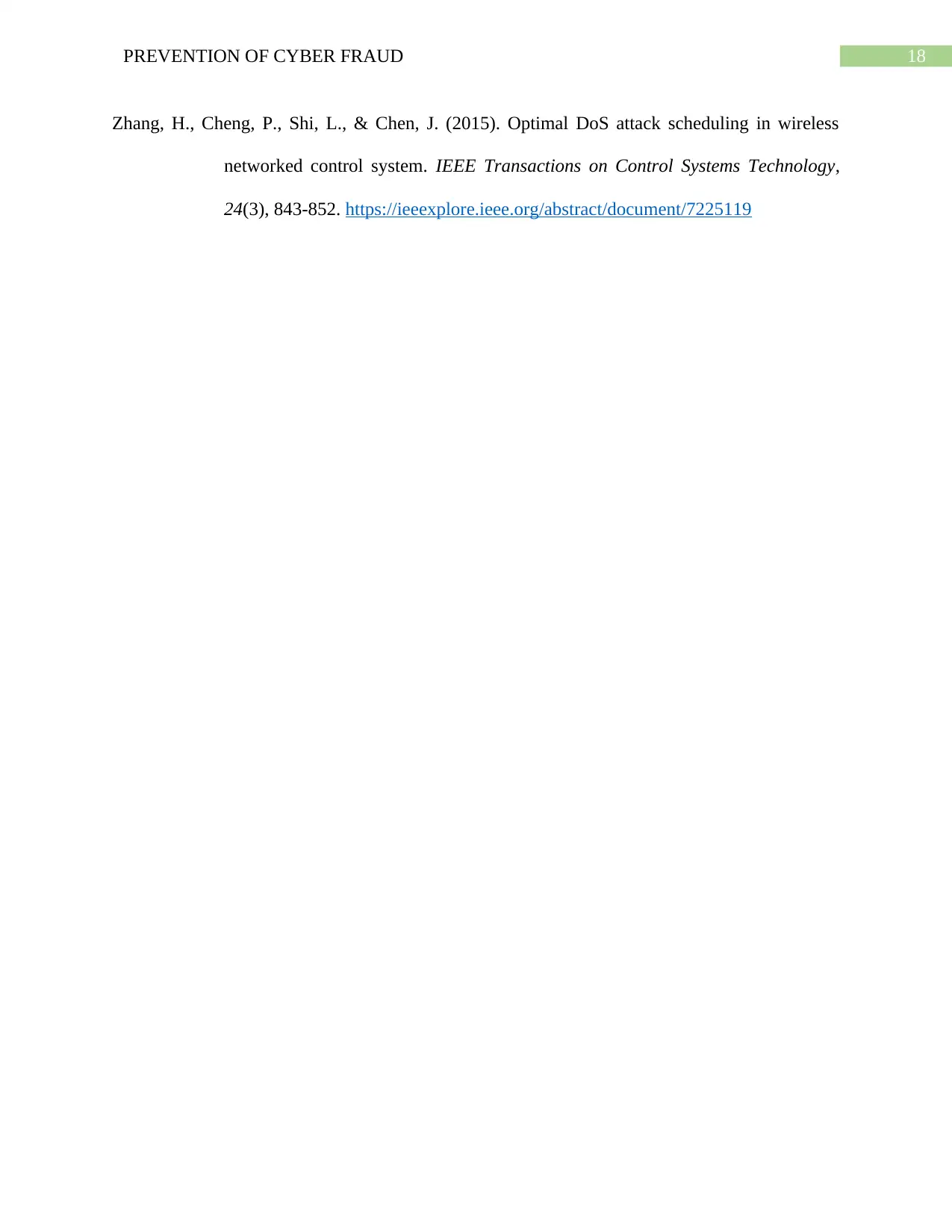
18PREVENTION OF CYBER FRAUD
Zhang, H., Cheng, P., Shi, L., & Chen, J. (2015). Optimal DoS attack scheduling in wireless
networked control system. IEEE Transactions on Control Systems Technology,
24(3), 843-852. https://ieeexplore.ieee.org/abstract/document/7225119
Zhang, H., Cheng, P., Shi, L., & Chen, J. (2015). Optimal DoS attack scheduling in wireless
networked control system. IEEE Transactions on Control Systems Technology,
24(3), 843-852. https://ieeexplore.ieee.org/abstract/document/7225119
1 out of 19
Related Documents
Your All-in-One AI-Powered Toolkit for Academic Success.
+13062052269
info@desklib.com
Available 24*7 on WhatsApp / Email
![[object Object]](/_next/static/media/star-bottom.7253800d.svg)
Unlock your academic potential
© 2024 | Zucol Services PVT LTD | All rights reserved.





